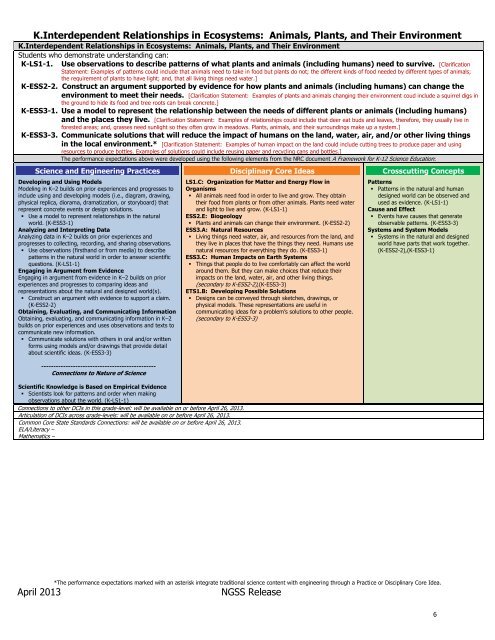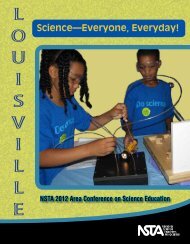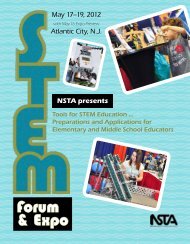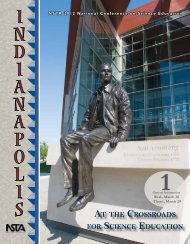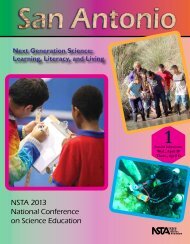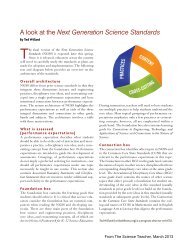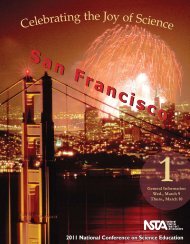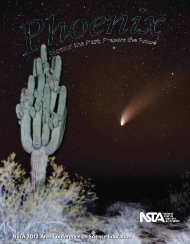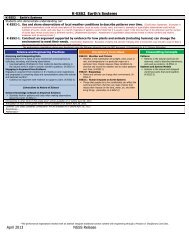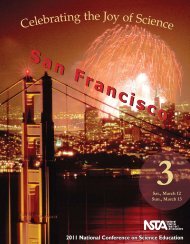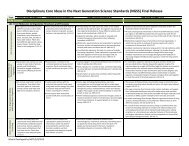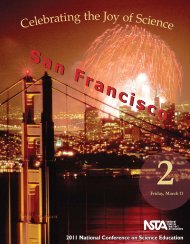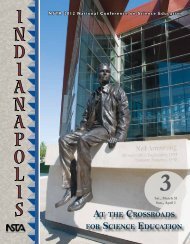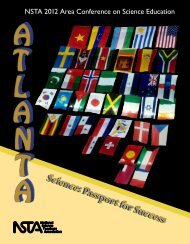K.Interdependent Relationships in Ecosystems: Animals, Plants, and ...
K.Interdependent Relationships in Ecosystems: Animals, Plants, and ...
K.Interdependent Relationships in Ecosystems: Animals, Plants, and ...
Create successful ePaper yourself
Turn your PDF publications into a flip-book with our unique Google optimized e-Paper software.
2.<strong>Interdependent</strong> <strong>Relationships</strong> <strong>in</strong> <strong>Ecosystems</strong>2.<strong>Interdependent</strong> <strong>Relationships</strong> <strong>in</strong> <strong>Ecosystems</strong>Students who demonstrate underst<strong>and</strong><strong>in</strong>g can:2-LS2-1. Plan <strong>and</strong> conduct an <strong>in</strong>vestigation to determ<strong>in</strong>e if plants need sunlight <strong>and</strong> water to grow. [Assessment Boundary: Assessmentis limited to test<strong>in</strong>g one variable at a time.]2-LS2-2. Develop a simple model that mimics the function of an animal <strong>in</strong> dispers<strong>in</strong>g seeds or poll<strong>in</strong>at<strong>in</strong>g plants.*2-LS4-1. Make observations of plants <strong>and</strong> animals to compare the diversity of life <strong>in</strong> different habitats. [Clarification Statement:Emphasis is on the diversity of liv<strong>in</strong>g th<strong>in</strong>gs <strong>in</strong> each of a variety of different habitats.] [Assessment Boundary: Assessment does not <strong>in</strong>clude specific animal <strong>and</strong> plantnames <strong>in</strong> specific habitats.]The performance expectations above were developed us<strong>in</strong>g the follow<strong>in</strong>g elements from the NRC document A Framework for K-12 Science Education:Science <strong>and</strong> Eng<strong>in</strong>eer<strong>in</strong>g PracticesDevelop<strong>in</strong>g <strong>and</strong> Us<strong>in</strong>g ModelsModel<strong>in</strong>g <strong>in</strong> K–2 builds on prior experiences <strong>and</strong> progresses to<strong>in</strong>clude us<strong>in</strong>g <strong>and</strong> develop<strong>in</strong>g models (i.e., diagram, draw<strong>in</strong>g,physical replica, diorama, dramatization, or storyboard) thatrepresent concrete events or design solutions.• Develop a simple model based on evidence to represent aproposed object or tool. (2-LS2-2)Plann<strong>in</strong>g <strong>and</strong> Carry<strong>in</strong>g Out InvestigationsPlann<strong>in</strong>g <strong>and</strong> carry<strong>in</strong>g out <strong>in</strong>vestigations to answer questions ortest solutions to problems <strong>in</strong> K–2 builds on prior experiences <strong>and</strong>progresses to simple <strong>in</strong>vestigations, based on fair tests, whichprovide data to support explanations or design solutions.• Plan <strong>and</strong> conduct an <strong>in</strong>vestigation collaboratively to producedata to serve as the basis for evidence to answer aquestion. (2-LS2-1)• Make observations (firsth<strong>and</strong> or from media) to collect datawhich can be used to make comparisons. (2-LS4-1)-------------------------------------------------------Connections to Nature of ScienceScientific Knowledge is Based on Empirical Evidence• Scientists look for patterns <strong>and</strong> order when mak<strong>in</strong>gobservations about the world. (2-LS4-1)Connections to other DCIs <strong>in</strong> this grade-level: will be available on or before April 26, 2013.Articulation of DCIs across grade-levels: will be available on or before April 26, 2013.Common Core State St<strong>and</strong>ards Connections: will be available on or before April 26, 2013.ELA/Literacy –Mathematics –Discipl<strong>in</strong>ary Core IdeasLS2.A: <strong>Interdependent</strong> <strong>Relationships</strong> <strong>in</strong> <strong>Ecosystems</strong>• <strong>Plants</strong> depend on water <strong>and</strong> light to grow. (2-LS2-1)• <strong>Plants</strong> depend on animals for poll<strong>in</strong>ation or to move their seedsaround. (2-LS2-2)LS4.D: Biodiversity <strong>and</strong> Humans• There are many different k<strong>in</strong>ds of liv<strong>in</strong>g th<strong>in</strong>gs <strong>in</strong> any area, <strong>and</strong>they exist <strong>in</strong> different places on l<strong>and</strong> <strong>and</strong> <strong>in</strong> water. (2-LS4-1)ETS1.B: Develop<strong>in</strong>g Possible Solutions• Designs can be conveyed through sketches, draw<strong>in</strong>gs, orphysical models. These representations are useful <strong>in</strong>communicat<strong>in</strong>g ideas for a problem’s solutions to other people.(secondary to 2-LS2-2)Crosscutt<strong>in</strong>g ConceptsCause <strong>and</strong> Effect• Events have causes that generateobservable patterns. (2-LS2-1)Structure <strong>and</strong> Function• The shape <strong>and</strong> stability of structuresof natural <strong>and</strong> designed objects arerelated to their function(s). (2-LS2-2)*The performance expectations marked with an asterisk <strong>in</strong>tegrate traditional science content with eng<strong>in</strong>eer<strong>in</strong>g through a Practice or Discipl<strong>in</strong>ary Core Idea.April 2013NGSS Release14
3.<strong>Interdependent</strong> <strong>Relationships</strong> <strong>in</strong> <strong>Ecosystems</strong>3.<strong>Interdependent</strong> <strong>Relationships</strong> <strong>in</strong> <strong>Ecosystems</strong>Students who demonstrate underst<strong>and</strong><strong>in</strong>g can:3-LS2-1. Construct an argument that some animals form groups that help members survive.3-LS4-1. Analyze <strong>and</strong> <strong>in</strong>terpret data from fossils to provide evidence of the organisms <strong>and</strong> the environments <strong>in</strong> which theylived long ago. [Clarification Statement: Examples of data could <strong>in</strong>clude type, size, <strong>and</strong> distributions of fossil organisms. Examples of fossils <strong>and</strong> environmentscould <strong>in</strong>clude mar<strong>in</strong>e fossils found on dry l<strong>and</strong>, tropical plant fossils found <strong>in</strong> Arctic areas, <strong>and</strong> fossils of ext<strong>in</strong>ct organisms.] [Assessment Boundary: Assessment does not<strong>in</strong>clude identification of specific fossils or present plants <strong>and</strong> animals. Assessment is limited to major fossil types <strong>and</strong> relative ages.]3-LS4-3. Construct an argument with evidence that <strong>in</strong> a particular habitat some organisms can survive well, some surviveless well, <strong>and</strong> some cannot survive at all. [Clarification Statement: Examples of evidence could <strong>in</strong>clude needs <strong>and</strong> characteristics of the organisms <strong>and</strong>habitats <strong>in</strong>volved. The organisms <strong>and</strong> their habitat make up a system <strong>in</strong> which the parts depend on each other.]3-LS4-4. Make a claim about the merit of a solution to a problem caused when the environment changes <strong>and</strong> the types ofplants <strong>and</strong> animals that live there may change.* [Clarification Statement: Examples of environmental changes could <strong>in</strong>clude changes <strong>in</strong> l<strong>and</strong>characteristics, water distribution, temperature, food, <strong>and</strong> other organisms.] [Assessment Boundary: Assessment is limited to a s<strong>in</strong>gle environmental change.Assessment does not <strong>in</strong>clude the greenhouse effect or climate change.]The performance expectations above were developed us<strong>in</strong>g the follow<strong>in</strong>g elements from the NRC document A Framework for K-12 Science Education:Science <strong>and</strong> Eng<strong>in</strong>eer<strong>in</strong>g PracticesAnalyz<strong>in</strong>g <strong>and</strong> Interpret<strong>in</strong>g DataAnalyz<strong>in</strong>g data <strong>in</strong> 3–5 builds on K–2 experiences <strong>and</strong>progresses to <strong>in</strong>troduc<strong>in</strong>g quantitative approaches tocollect<strong>in</strong>g data <strong>and</strong> conduct<strong>in</strong>g multiple trials of qualitativeobservations. When possible <strong>and</strong> feasible, digital toolsshould be used.• Analyze <strong>and</strong> <strong>in</strong>terpret data to make sense ofphenomena us<strong>in</strong>g logical reason<strong>in</strong>g. (3-LS4-1)Engag<strong>in</strong>g <strong>in</strong> Argument from EvidenceEngag<strong>in</strong>g <strong>in</strong> argument from evidence <strong>in</strong> 3–5 builds on K–2experiences <strong>and</strong> progresses to critiqu<strong>in</strong>g the scientificexplanations or solutions proposed by peers by cit<strong>in</strong>grelevant evidence about the natural <strong>and</strong> designed worlds.• Construct an argument with evidence, data, <strong>and</strong>/or amodel. (3-LS2-1)• Construct an argument with evidence. (3-LS4-3)• Make a claim about the merit of a solution to a problemby cit<strong>in</strong>g relevant evidence about how it meets thecriteria <strong>and</strong> constra<strong>in</strong>ts of the problem. (3-LS4-4)Connections to other DCIs <strong>in</strong> this grade-level: will be available on or before April 26, 2013.Articulation of DCIs across grade-levels: will be available on or before April 26, 2013.Common Core State St<strong>and</strong>ards Connections: will be available on or before April 26, 2013.ELA/Literacy –Mathematics –Discipl<strong>in</strong>ary Core IdeasLS2.C: Ecosystem Dynamics, Function<strong>in</strong>g, <strong>and</strong> Resilience• When the environment changes <strong>in</strong> ways that affect a place’sphysical characteristics, temperature, or availability ofresources, some organisms survive <strong>and</strong> reproduce, othersmove to new locations, yet others move <strong>in</strong>to the transformedenvironment, <strong>and</strong> some die. (secondary to 3-LS4-4)LS2.D: Social Interactions <strong>and</strong> Group Behavior• Be<strong>in</strong>g part of a group helps animals obta<strong>in</strong> food, defendthemselves, <strong>and</strong> cope with changes. Groups may servedifferent functions <strong>and</strong> vary dramatically <strong>in</strong> size. (Note: Movedfrom K–2) (3-LS2-1)LS4.A: Evidence of Common Ancestry <strong>and</strong> Diversity• Some k<strong>in</strong>ds of plants <strong>and</strong> animals that once lived on Earth areno longer found anywhere. (Note: Moved from K–2) (3-LS4-1)• Fossils provide evidence about the types of organisms thatlived long ago <strong>and</strong> also about the nature of their environments.(3-LS4-1)LS4.C: Adaptation• For any particular environment, some k<strong>in</strong>ds of organismssurvive well, some survive less well, <strong>and</strong> some cannot surviveat all. (3-LS4-3)LS4.D: Biodiversity <strong>and</strong> Humans• Populations live <strong>in</strong> a variety of habitats, <strong>and</strong> change <strong>in</strong> thosehabitats affects the organisms liv<strong>in</strong>g there. (3-LS4-4)Crosscutt<strong>in</strong>g ConceptsCause <strong>and</strong> Effect• Cause <strong>and</strong> effect relationships are rout<strong>in</strong>elyidentified <strong>and</strong> used to expla<strong>in</strong> change. (3-LS2-1),(3-LS4-3)Scale, Proportion, <strong>and</strong> Quantity• Observable phenomena exist from very shortto very long time periods. (3-LS4-1)Systems <strong>and</strong> System Models• A system can be described <strong>in</strong> terms of itscomponents <strong>and</strong> their <strong>in</strong>teractions. (3-LS4-4)-------------------------------------------------Connections to Eng<strong>in</strong>eer<strong>in</strong>g, Technology,<strong>and</strong> Applications of ScienceInterdependence of Science, Eng<strong>in</strong>eer<strong>in</strong>g,<strong>and</strong> Technology• Knowledge of relevant scientific concepts <strong>and</strong>research f<strong>in</strong>d<strong>in</strong>gs is important <strong>in</strong> eng<strong>in</strong>eer<strong>in</strong>g.(3-LS4-3)-------------------------------------------------Connections to Nature of ScienceScientific Knowledge Assumes an Order <strong>and</strong>Consistency <strong>in</strong> Natural Systems• Science assumes consistent patterns <strong>in</strong>natural systems. (3-LS4-1)Science is a Human Endeavor• Most scientists <strong>and</strong> eng<strong>in</strong>eers work <strong>in</strong> teams.(3-LS4-3)*The performance expectations marked with an asterisk <strong>in</strong>tegrate traditional science content with eng<strong>in</strong>eer<strong>in</strong>g through a Practice or Discipl<strong>in</strong>ary Core Idea.April 2013NGSS Release19
3.Inheritance <strong>and</strong> Variation of Traits: Life Cycles <strong>and</strong> Traits3.Inheritance <strong>and</strong> Variation of Traits: Life Cycles <strong>and</strong> TraitsStudents who demonstrate underst<strong>and</strong><strong>in</strong>g can:3-LS1-1. Develop models to describe that organisms have unique <strong>and</strong> diverse life cycles but all have <strong>in</strong> common birth,growth, reproduction, <strong>and</strong> death. [Clarification Statement: Changes organisms go through dur<strong>in</strong>g their life form a pattern.] [Assessment Boundary:Assessment of plant life cycles is limited to those of flower<strong>in</strong>g plants. Assessment does not <strong>in</strong>clude details of human reproduction.]3-LS3-1. Analyze <strong>and</strong> <strong>in</strong>terpret data to provide evidence that plants <strong>and</strong> animals have traits <strong>in</strong>herited from parents <strong>and</strong> thatvariation of these traits exists <strong>in</strong> a group of similar organisms. [Clarification Statement: Patterns are the similarities <strong>and</strong> differences <strong>in</strong>traits shared between offspr<strong>in</strong>g <strong>and</strong> their parents, or among sibl<strong>in</strong>gs. Emphasis is on organisms other than humans.] [Assessment Boundary: Assessment does not<strong>in</strong>clude genetic mechanisms of <strong>in</strong>heritance <strong>and</strong> prediction of traits. Assessment is limited to non-human examples.]3-LS3-2. Use evidence to support the explanation that traits can be <strong>in</strong>fluenced by the environment. [Clarification Statement: Examplesof the environment affect<strong>in</strong>g a trait could <strong>in</strong>clude normally tall plants grown with <strong>in</strong>sufficient water are stunted; <strong>and</strong>, a pet dog that is given too much food <strong>and</strong> littleexercise may become overweight.]3-LS4-2. Use evidence to construct an explanation for how the variations <strong>in</strong> characteristics among <strong>in</strong>dividuals of the samespecies may provide advantages <strong>in</strong> surviv<strong>in</strong>g, f<strong>in</strong>d<strong>in</strong>g mates, <strong>and</strong> reproduc<strong>in</strong>g. [Clarification Statement: Examples of cause <strong>and</strong>effect relationships could be plants that have larger thorns than other plants may be less likely to be eaten by predators; <strong>and</strong>, animals that have better camouflagecoloration than other animals may be more likely to survive <strong>and</strong> therefore more likely to leave offspr<strong>in</strong>g.]The performance expectations above were developed us<strong>in</strong>g the follow<strong>in</strong>g elements from the NRC document A Framework for K-12 Science Education:Science <strong>and</strong> Eng<strong>in</strong>eer<strong>in</strong>g PracticesDevelop<strong>in</strong>g <strong>and</strong> Us<strong>in</strong>g ModelsModel<strong>in</strong>g <strong>in</strong> 3–5 builds on K–2 experiences <strong>and</strong> progresses tobuild<strong>in</strong>g <strong>and</strong> revis<strong>in</strong>g simple models <strong>and</strong> us<strong>in</strong>g models torepresent events <strong>and</strong> design solutions.• Develop models to describe phenomena. (3-LS1-1)Analyz<strong>in</strong>g <strong>and</strong> Interpret<strong>in</strong>g DataAnalyz<strong>in</strong>g data <strong>in</strong> 3–5 builds on K–2 experiences <strong>and</strong> progressesto <strong>in</strong>troduc<strong>in</strong>g quantitative approaches to collect<strong>in</strong>g data <strong>and</strong>conduct<strong>in</strong>g multiple trials of qualitative observations.When possible <strong>and</strong> feasible, digital tools should be used.• Analyze <strong>and</strong> <strong>in</strong>terpret data to make sense of phenomenaus<strong>in</strong>g logical reason<strong>in</strong>g. (3-LS3-1)Construct<strong>in</strong>g Explanations <strong>and</strong> Design<strong>in</strong>g SolutionsConstruct<strong>in</strong>g explanations <strong>and</strong> design<strong>in</strong>g solutions <strong>in</strong> 3–5 buildson K–2 experiences <strong>and</strong> progresses to the use of evidence <strong>in</strong>construct<strong>in</strong>g explanations that specify variables that describe <strong>and</strong>predict phenomena <strong>and</strong> <strong>in</strong> design<strong>in</strong>g multiple solutions to designproblems.• Use evidence (e.g., observations, patterns) to support anexplanation. (3-LS3-2)• Use evidence (e.g., observations, patterns) to construct anexplanation. (3-LS4-2)----------------------------------------------------------Connections to Nature of ScienceScientific Knowledge is Based on Empirical Evidence• Science f<strong>in</strong>d<strong>in</strong>gs are based on recogniz<strong>in</strong>g patterns. (3-LS1-1)Connections to other DCIs <strong>in</strong> this grade-level: will be available on or before April 26, 2013.Articulation of DCIs across grade-levels: will be available on or before April 26, 2013.Common Core State St<strong>and</strong>ards Connections: will be available on or before April 26, 2013.ELA/Literacy –Mathematics –Discipl<strong>in</strong>ary Core IdeasLS1.B: Growth <strong>and</strong> Development of Organisms• Reproduction is essential to the cont<strong>in</strong>ued existence of everyk<strong>in</strong>d of organism. <strong>Plants</strong> <strong>and</strong> animals have unique <strong>and</strong> diverselife cycles. (3-LS1-1)LS3.A: Inheritance of Traits• Many characteristics of organisms are <strong>in</strong>herited from theirparents. (3-LS3-1)• Other characteristics result from <strong>in</strong>dividuals’ <strong>in</strong>teractions withthe environment, which can range from diet to learn<strong>in</strong>g. Manycharacteristics <strong>in</strong>volve both <strong>in</strong>heritance <strong>and</strong> environment. (3-LS3-2)LS3.B: Variation of Traits• Different organisms vary <strong>in</strong> how they look <strong>and</strong> functionbecause they have different <strong>in</strong>herited <strong>in</strong>formation. (3-LS3-1)• The environment also affects the traits that an organismdevelops. (3-LS3-2)LS4.B: Natural Selection• Sometimes the differences <strong>in</strong> characteristics between<strong>in</strong>dividuals of the same species provide advantages <strong>in</strong>surviv<strong>in</strong>g, f<strong>in</strong>d<strong>in</strong>g mates, <strong>and</strong> reproduc<strong>in</strong>g. (3-LS4-2)Crosscutt<strong>in</strong>g ConceptsPatterns• Similarities <strong>and</strong> differences <strong>in</strong> patternscan be used to sort <strong>and</strong> classify naturalphenomena. (3-LS3-1)• Patterns of change can be used to makepredictions. (3-LS1-1)Cause <strong>and</strong> Effect• Cause <strong>and</strong> effect relationships arerout<strong>in</strong>ely identified <strong>and</strong> used to expla<strong>in</strong>change. (3-LS3-2),(3-LS4-2)*The performance expectations marked with an asterisk <strong>in</strong>tegrate traditional science content with eng<strong>in</strong>eer<strong>in</strong>g through a Practice or Discipl<strong>in</strong>ary Core Idea.April 2013NGSS Release20
4.Structure, Function, <strong>and</strong> Information Process<strong>in</strong>g4.Structure, Function, <strong>and</strong> Information Process<strong>in</strong>gStudents who demonstrate underst<strong>and</strong><strong>in</strong>g can:4-PS4-2. Develop a model to describe that light reflect<strong>in</strong>g from objects <strong>and</strong> enter<strong>in</strong>g the eye allows objects to be seen.[Assessment Boundary: Assessment does not <strong>in</strong>clude knowledge of specific colors reflected <strong>and</strong> seen, the cellular mechanisms of vision, or how the ret<strong>in</strong>a works.]4-LS1-1. Construct an argument that plants <strong>and</strong> animals have <strong>in</strong>ternal <strong>and</strong> external structures that function to supportsurvival, growth, behavior, <strong>and</strong> reproduction. [Clarification Statement: Examples of structures could <strong>in</strong>clude thorns, stems, roots, colored petals,heart, stomach, lung, bra<strong>in</strong>, <strong>and</strong> sk<strong>in</strong>.] [Assessment Boundary: Assessment is limited to macroscopic structures with<strong>in</strong> plant <strong>and</strong> animal systems.]4-LS1-2. Use a model to describe that animals’ receive different types of <strong>in</strong>formation through their senses, process the<strong>in</strong>formation <strong>in</strong> their bra<strong>in</strong>, <strong>and</strong> respond to the <strong>in</strong>formation <strong>in</strong> different ways. [Clarification Statement: Emphasis is on systems of<strong>in</strong>formation transfer. ] [Assessment Boundary: Assessment does not <strong>in</strong>clude the mechanisms by which the bra<strong>in</strong> stores <strong>and</strong> recalls <strong>in</strong>formation or the mechanisms ofhow sensory receptors function.]The performance expectations above were developed us<strong>in</strong>g the follow<strong>in</strong>g elements from the NRC document A Framework for K-12 Science Education:Science <strong>and</strong> Eng<strong>in</strong>eer<strong>in</strong>g PracticesDevelop<strong>in</strong>g <strong>and</strong> Us<strong>in</strong>g ModelsModel<strong>in</strong>g <strong>in</strong> 3–5 builds on K–2 experiences <strong>and</strong> progresses tobuild<strong>in</strong>g <strong>and</strong> revis<strong>in</strong>g simple models <strong>and</strong> us<strong>in</strong>g models to representevents <strong>and</strong> design solutions.• Develop a model to describe phenomena. (4-PS4-2)• Use a model to test <strong>in</strong>teractions concern<strong>in</strong>g the function<strong>in</strong>g of anatural system. (4-LS-1-2)Engag<strong>in</strong>g <strong>in</strong> Argument from EvidenceEngag<strong>in</strong>g <strong>in</strong> argument from evidence <strong>in</strong> 3–5 builds on K–2experiences <strong>and</strong> progresses to critiqu<strong>in</strong>g the scientific explanationsor solutions proposed by peers by cit<strong>in</strong>g relevant evidence aboutthe natural <strong>and</strong> designed world(s).• Construct an argument with evidence, data, <strong>and</strong>/or a model.(4-LS1-1)Connections to other DCIs <strong>in</strong> this grade-level: will be available on or before April 26, 2013.Articulation of DCIs across grade-levels: will be available on or before April 26, 2013.Common Core State St<strong>and</strong>ards Connections: will be available on or before April 26, 2013.ELA/Literacy –Mathematics –Discipl<strong>in</strong>ary Core IdeasPS4.B: Electromagnetic Radiation• An object can be seen when light reflected from its surfaceenters the eyes. (4-PS4-2)LS1.A: Structure <strong>and</strong> Function• <strong>Plants</strong> <strong>and</strong> animals have both <strong>in</strong>ternal <strong>and</strong> externalstructures that serve various functions <strong>in</strong> growth, survival,behavior, <strong>and</strong> reproduction. (4-LS1-1)LS1.D: Information Process<strong>in</strong>g• Different sense receptors are specialized for particulark<strong>in</strong>ds of <strong>in</strong>formation, which may be then processed by theanimal’s bra<strong>in</strong>. <strong>Animals</strong> are able to use their perceptions<strong>and</strong> memories to guide their actions. (4-LS1-2)Crosscutt<strong>in</strong>g ConceptsCause <strong>and</strong> Effect• Cause <strong>and</strong> effect relationships arerout<strong>in</strong>ely identified. (4-PS4-2)Systems <strong>and</strong> System Models• A system can be described <strong>in</strong> terms of itscomponents <strong>and</strong> their <strong>in</strong>teractions. (4-LS1-1), (LS1-2)*The performance expectations marked with an asterisk <strong>in</strong>tegrate traditional science content with eng<strong>in</strong>eer<strong>in</strong>g through a Practice or Discipl<strong>in</strong>ary Core Idea.April 2013NGSS Release25
Middle School Life SciencesStudents <strong>in</strong> middle school develop underst<strong>and</strong><strong>in</strong>g of key concepts to help them make sense ofthe life sciences. These ideas build upon students’ science underst<strong>and</strong><strong>in</strong>g from earlier grades<strong>and</strong> from the discipl<strong>in</strong>ary core ideas, science <strong>and</strong> eng<strong>in</strong>eer<strong>in</strong>g practices, <strong>and</strong> crosscutt<strong>in</strong>gconcepts of other experiences with physical <strong>and</strong> earth sciences. There are five life science topics<strong>in</strong> middle school: 1) Structure, Function, <strong>and</strong> Information Process<strong>in</strong>g, 2) Growth, Development,<strong>and</strong> Reproduction of Organisms, 3) Matter <strong>and</strong> Energy <strong>in</strong> Organisms <strong>and</strong> <strong>Ecosystems</strong>, 4)<strong>Interdependent</strong> <strong>Relationships</strong> <strong>in</strong> <strong>Ecosystems</strong>, <strong>and</strong> 5) Natural Selection <strong>and</strong> Adaptations. Theperformance expectations <strong>in</strong> middle school blend core ideas with scientific <strong>and</strong> eng<strong>in</strong>eer<strong>in</strong>gpractices <strong>and</strong> crosscutt<strong>in</strong>g concepts to support students <strong>in</strong> develop<strong>in</strong>g useable knowledge acrossthe science discipl<strong>in</strong>es. While the performance expectations <strong>in</strong> middle school life science coupleparticular practices with specific discipl<strong>in</strong>ary core ideas, <strong>in</strong>structional decisions should <strong>in</strong>cludeuse of many science <strong>and</strong> eng<strong>in</strong>eer<strong>in</strong>g practices <strong>in</strong>tegrated <strong>in</strong> the performance expectations. Theconcepts <strong>and</strong> practices <strong>in</strong> the performance expectations are based on the grade-b<strong>and</strong> endpo<strong>in</strong>tsdescribed <strong>in</strong> A Framework for K-12 Science Education (NRC, 2012).The Performance Expectations <strong>in</strong> Structure, Function, <strong>and</strong> Information Process<strong>in</strong>g helpstudents formulate an answer to the question, “How do the structures of organisms contributeto life’s functions?” Middle school students can plan <strong>and</strong> carry out <strong>in</strong>vestigations to developevidence that liv<strong>in</strong>g organisms are made of cells <strong>and</strong> to determ<strong>in</strong>e the relationship of organismsto the environment. Students can use underst<strong>and</strong><strong>in</strong>g of cell theory to develop physical <strong>and</strong>conceptual models of cells. They can construct explanations for the <strong>in</strong>teractions of systems <strong>in</strong>cells <strong>and</strong> organisms <strong>and</strong> how organisms gather <strong>and</strong> use <strong>in</strong>formation from the environment. Bythe end of their studies, students underst<strong>and</strong> that all organisms are made of cells, that specialstructures are responsible for particular functions <strong>in</strong> organisms, <strong>and</strong> that for many organismsthe body is a system of multiple <strong>in</strong>teract<strong>in</strong>g subsystems that form a hierarchy from cells to thebody. Crosscutt<strong>in</strong>g concepts of cause <strong>and</strong> effect, structure <strong>and</strong> function, <strong>and</strong> matter <strong>and</strong> energyare called out as organiz<strong>in</strong>g concepts for these core ideas.The Performance Expectations <strong>in</strong> Growth, Development, <strong>and</strong> Reproduction of Organismshelp students formulate an answer to the question, “How do organisms grow, develop, <strong>and</strong>reproduce?” Students underst<strong>and</strong> how the environment <strong>and</strong> genetic factors determ<strong>in</strong>e thegrowth of an <strong>in</strong>dividual organism. They also demonstrate underst<strong>and</strong><strong>in</strong>g of the geneticimplications for sexual <strong>and</strong> asexual reproduction. Students can develop evidence to supporttheir underst<strong>and</strong><strong>in</strong>g of the structures <strong>and</strong> behaviors that <strong>in</strong>crease the likelihood of successfulreproduction by organisms. They have a beg<strong>in</strong>n<strong>in</strong>g underst<strong>and</strong><strong>in</strong>g of the ways humans canselect for specific traits, the role of technology, genetic modification, <strong>and</strong> the nature of ethicalresponsibilities related to selective breed<strong>in</strong>g. At the end of middle school, students can expla<strong>in</strong>how selected structures, functions, <strong>and</strong> behaviors of organisms change <strong>in</strong> predictable ways asthey progress from birth to old age. Students can use the practices of analyz<strong>in</strong>g <strong>and</strong><strong>in</strong>terpret<strong>in</strong>g data, us<strong>in</strong>g models, conduct<strong>in</strong>g <strong>in</strong>vestigations <strong>and</strong> communicat<strong>in</strong>g <strong>in</strong>formation.Crosscutt<strong>in</strong>g concepts of structure <strong>and</strong> function, change <strong>and</strong> stability, <strong>and</strong> matter <strong>and</strong> energyflow <strong>in</strong> organisms support underst<strong>and</strong><strong>in</strong>g across this topic.April 2013NGSS Release40
The Performance Expectations <strong>in</strong> Matter <strong>and</strong> Energy <strong>in</strong> Organisms <strong>and</strong> <strong>Ecosystems</strong> helpstudents formulate answers to the questions: “How do organisms obta<strong>in</strong> <strong>and</strong> use matter <strong>and</strong>energy? How do matter <strong>and</strong> energy move through an ecosystem?” Middle school students canuse conceptual <strong>and</strong> physical models to expla<strong>in</strong> the transfer of energy <strong>and</strong> cycl<strong>in</strong>g of matter asthey construct explanations for the role of photosynthesis <strong>in</strong> cycl<strong>in</strong>g matter <strong>in</strong> ecosystems. Theycan construct explanations for the cycl<strong>in</strong>g of matter <strong>in</strong> organisms <strong>and</strong> the <strong>in</strong>teractions oforganisms to obta<strong>in</strong> the matter <strong>and</strong> energy from the ecosystem to survive <strong>and</strong> grow. Studentshave a grade-appropriate underst<strong>and</strong><strong>in</strong>g <strong>and</strong> use of the practices of <strong>in</strong>vestigations, construct<strong>in</strong>garguments based on evidence, <strong>and</strong> oral <strong>and</strong> written communication. They underst<strong>and</strong> thatsusta<strong>in</strong><strong>in</strong>g life requires substantial energy <strong>and</strong> matter <strong>in</strong>puts <strong>and</strong> the structure <strong>and</strong> functions oforganisms contribute to the capture, transformation, transport, release, <strong>and</strong> elim<strong>in</strong>ation ofmatter <strong>and</strong> energy. Add<strong>in</strong>g to these crosscutt<strong>in</strong>g concepts is a deeper underst<strong>and</strong><strong>in</strong>g of systems<strong>and</strong> system models that ties the performances expectations <strong>in</strong> this topic together.The Performance Expectations <strong>in</strong> <strong>Interdependent</strong> <strong>Relationships</strong> <strong>in</strong> <strong>Ecosystems</strong> helpstudents formulate an answer to the question, “How do organisms <strong>in</strong>teract with otherorganisms <strong>in</strong> the physical environment to obta<strong>in</strong> matter <strong>and</strong> energy? To answer the question,middle school students construct explanations for the <strong>in</strong>teractions <strong>in</strong> ecosystems <strong>and</strong> thescientific, economic, political, <strong>and</strong> social justifications used <strong>in</strong> mak<strong>in</strong>g decisions aboutma<strong>in</strong>ta<strong>in</strong><strong>in</strong>g biodiversity <strong>in</strong> ecosystems. Students can use models, construct evidence-basedexplanations, <strong>and</strong> use argumentation from evidence. Students underst<strong>and</strong> that organisms <strong>and</strong>populations of organisms are dependent on their environmental <strong>in</strong>teractions both with otherorganisms <strong>and</strong> with nonliv<strong>in</strong>g factors. They also underst<strong>and</strong> the limits of resources <strong>in</strong>fluence thegrowth of organisms <strong>and</strong> populations, which may result <strong>in</strong> competition for those limitedresources. Crosscutt<strong>in</strong>g concepts of matter <strong>and</strong> energy, systems <strong>and</strong> system models, <strong>and</strong> cause<strong>and</strong> effect are used by students to support underst<strong>and</strong><strong>in</strong>g the phenomena they study.The Performance Expectations <strong>in</strong> Natural Selection <strong>and</strong> Adaptations help studentsformulate answers to the questions: “How does genetic variation among organisms <strong>in</strong> a speciesaffect survival <strong>and</strong> reproduction? How does the environment <strong>in</strong>fluence genetic traits <strong>in</strong>populations over multiple generations?” Middle school students can analyze data from the fossilrecord to describe evidence of the history of life on Earth <strong>and</strong> can construct explanations forsimilarities <strong>in</strong> organisms. They have a beg<strong>in</strong>n<strong>in</strong>g underst<strong>and</strong><strong>in</strong>g of the role of variation <strong>in</strong> naturalselection <strong>and</strong> how this leads to speciation. They have a grade-appropriate underst<strong>and</strong><strong>in</strong>g <strong>and</strong>use of the practices of analyz<strong>in</strong>g graphical displays; us<strong>in</strong>g mathematical models; <strong>and</strong> gather<strong>in</strong>g,read<strong>in</strong>g, <strong>and</strong> communicat<strong>in</strong>g <strong>in</strong>formation. The crosscutt<strong>in</strong>g concept of cause <strong>and</strong> effect iscentral to this topic.April 2013NGSS Release41
MS.Structure, Function, <strong>and</strong> Information Process<strong>in</strong>gMS.Structure, Function, <strong>and</strong> Information Process<strong>in</strong>gStudents who demonstrate underst<strong>and</strong><strong>in</strong>g can:MS-LS1-1. Conduct an <strong>in</strong>vestigation to provide evidence that liv<strong>in</strong>g th<strong>in</strong>gs are made of cells, either one cell or manydifferent numbers <strong>and</strong> types of cells. [Clarification Statement: Emphasis is on develop<strong>in</strong>g evidence that liv<strong>in</strong>g th<strong>in</strong>gs are made of cells,dist<strong>in</strong>guish<strong>in</strong>g between liv<strong>in</strong>g <strong>and</strong> non-liv<strong>in</strong>g cells, <strong>and</strong> underst<strong>and</strong><strong>in</strong>g that liv<strong>in</strong>g th<strong>in</strong>gs may be made of one cell or many <strong>and</strong> varied cells.]MS-LS1-2. Develop <strong>and</strong> use a model to describe the function of a cell as a whole <strong>and</strong> ways parts of cells contribute to thefunction. [Clarification Statement: Emphasis is on the cell function<strong>in</strong>g as a whole system <strong>and</strong> the primary role of identified parts of the cell, specifically thenucleus, chloroplasts, mitochondria, cell membrane, <strong>and</strong> cell wall.] [Assessment Boundary: Assessment of organelle structure/function relationships is limited to thecell wall <strong>and</strong> cell membrane. Assessment of the function of the other organelles is limited to their relationship to the whole cell. Assessment does not <strong>in</strong>clude thebiochemical function of cells or cell parts.]MS-LS1-3. Use argument supported by evidence for how the body is a system of <strong>in</strong>teract<strong>in</strong>g subsystems composed ofgroups of cells. [Clarification Statement: Emphasis is on the conceptual underst<strong>and</strong><strong>in</strong>g that cells form tissues <strong>and</strong> tissues form organs specialized forparticular body functions. Examples could <strong>in</strong>clude the <strong>in</strong>teraction of subsystems with<strong>in</strong> a system <strong>and</strong> the normal function<strong>in</strong>g of those systems.] [AssessmentBoundary: Assessment does not <strong>in</strong>clude the mechanism of one body system <strong>in</strong>dependent of others. Assessment is limited to the circulatory, excretory, digestive,respiratory, muscular, <strong>and</strong> nervous systems.]MS-LS1-8. Gather <strong>and</strong> synthesize <strong>in</strong>formation that sensory receptors respond to stimuli by send<strong>in</strong>g messages to the bra<strong>in</strong>for immediate behavior or storage as memories. [Assessment Boundary: Assessment does not <strong>in</strong>clude mechanisms for the transmission ofthis <strong>in</strong>formation.]Science <strong>and</strong> Eng<strong>in</strong>eer<strong>in</strong>g PracticesDevelop<strong>in</strong>g <strong>and</strong> Us<strong>in</strong>g ModelsModel<strong>in</strong>g <strong>in</strong> 6–8 builds on K–5 experiences <strong>and</strong> progressesto develop<strong>in</strong>g, us<strong>in</strong>g, <strong>and</strong> revis<strong>in</strong>g models to describe, test,<strong>and</strong> predict more abstract phenomena <strong>and</strong> designsystems.• Develop <strong>and</strong> use a model to describe phenomena.(MS-LS1-2)Plann<strong>in</strong>g <strong>and</strong> Carry<strong>in</strong>g Out InvestigationsPlann<strong>in</strong>g <strong>and</strong> carry<strong>in</strong>g out <strong>in</strong>vestigations <strong>in</strong> 6-8 builds on K-5 experiences <strong>and</strong> progresses to <strong>in</strong>clude <strong>in</strong>vestigations thatuse multiple variables <strong>and</strong> provide evidence to supportexplanations or solutions.• Conduct an <strong>in</strong>vestigation to produce data to serve asthe basis for evidence that meet the goals of an<strong>in</strong>vestigation. (MS-LS1-1)Engag<strong>in</strong>g <strong>in</strong> Argument from EvidenceEngag<strong>in</strong>g <strong>in</strong> argument from evidence <strong>in</strong> 6–8 builds on K–5experiences <strong>and</strong> progresses to construct<strong>in</strong>g a conv<strong>in</strong>c<strong>in</strong>gargument that supports or refutes claims for eitherexplanations or solutions about the natural <strong>and</strong> designedworld(s).• Use an oral <strong>and</strong> written argument supported byevidence to support or refute an explanation or amodel for a phenomenon. (MS-LS1-3)Obta<strong>in</strong><strong>in</strong>g, Evaluat<strong>in</strong>g, <strong>and</strong> Communicat<strong>in</strong>gInformationObta<strong>in</strong><strong>in</strong>g, evaluat<strong>in</strong>g, <strong>and</strong> communicat<strong>in</strong>g <strong>in</strong>formation <strong>in</strong>6-8 builds on K-5 experiences <strong>and</strong> progresses toevaluat<strong>in</strong>g the merit <strong>and</strong> validity of ideas <strong>and</strong> methods.• Gather, read, <strong>and</strong> synthesize <strong>in</strong>formation from multipleappropriate sources <strong>and</strong> assess the credibility,accuracy, <strong>and</strong> possible bias of each publication <strong>and</strong>methods used, <strong>and</strong> describe how they are supportedor not supported by evidence. (MS-LS1-8)Connections to other DCIs <strong>in</strong> this grade-level: will be available on or before April 26, 2013.Articulation to DCIs across grade-levels: will be available on or before April 26, 2013.Common Core State St<strong>and</strong>ards Connections: will be available on or before April 26, 2013.Discipl<strong>in</strong>ary Core IdeasLS1.A: Structure <strong>and</strong> Function• All liv<strong>in</strong>g th<strong>in</strong>gs are made up of cells, which is thesmallest unit that can be said to be alive. An organismmay consist of one s<strong>in</strong>gle cell (unicellular) or manydifferent numbers <strong>and</strong> types of cells (multicellular).(MS-LS1-1)• With<strong>in</strong> cells, special structures are responsible forparticular functions, <strong>and</strong> the cell membrane forms theboundary that controls what enters <strong>and</strong> leaves the cell.(MS-LS1-2)• In multicellular organisms, the body is a system ofmultiple <strong>in</strong>teract<strong>in</strong>g subsystems. These subsystems aregroups of cells that work together to form tissues <strong>and</strong>organs that are specialized for particular body functions.(MS-LS1-3)LS1.D: Information Process<strong>in</strong>g• Each sense receptor responds to different <strong>in</strong>puts(electromagnetic, mechanical, chemical), transmitt<strong>in</strong>gthem as signals that travel along nerve cells to thebra<strong>in</strong>. The signals are then processed <strong>in</strong> the bra<strong>in</strong>,result<strong>in</strong>g <strong>in</strong> immediate behaviors or memories. (MS-LS1-8)Crosscutt<strong>in</strong>g ConceptsCause <strong>and</strong> Effect• Cause <strong>and</strong> effect relationships may be used topredict phenomena <strong>in</strong> natural systems. (MS-LS1-8)Scale, Proportion, <strong>and</strong> Quantity• Phenomena that can be observed at one scale maynot be observable at another scale. (MS-LS1-1)Systems <strong>and</strong> System Models• Systems may <strong>in</strong>teract with other systems; they mayhave sub-systems <strong>and</strong> be a part of larger complexsystems. (MS-LS1-3)Structure <strong>and</strong> Function• Complex <strong>and</strong> microscopic structures <strong>and</strong> systems canbe visualized, modeled, <strong>and</strong> used to describe howtheir function depends on the relationships among itsparts, therefore complex natural <strong>and</strong> designedstructures/systems can be analyzed to determ<strong>in</strong>ehow they function. (MS-LS1-2)------------------------------------------------------Connections to Eng<strong>in</strong>eer<strong>in</strong>g, Technology,<strong>and</strong> Applications of ScienceInterdependence of Science, Eng<strong>in</strong>eer<strong>in</strong>g, <strong>and</strong>Technology• Eng<strong>in</strong>eer<strong>in</strong>g advances have led to importantdiscoveries <strong>in</strong> virtually every field of science, <strong>and</strong>scientific discoveries have led to the development ofentire <strong>in</strong>dustries <strong>and</strong> eng<strong>in</strong>eered systems. (MS-LS1-1)------------------------------------------------------Connections to Nature of ScienceScience is a Human Endeavor• Scientists <strong>and</strong> eng<strong>in</strong>eers are guided by habits of m<strong>in</strong>dsuch as <strong>in</strong>tellectual honesty, tolerance of ambiguity,skepticism, <strong>and</strong> openness to new ideas. (MS-LS1-3)*The performance expectations marked with an asterisk <strong>in</strong>tegrate traditional science content with eng<strong>in</strong>eer<strong>in</strong>g through a Practice or Discipl<strong>in</strong>ary Core Idea.April 2013NGSS Release42
MS.Matter <strong>and</strong> Energy <strong>in</strong> Organisms <strong>and</strong> <strong>Ecosystems</strong>MS.Matter <strong>and</strong> Energy <strong>in</strong> Organisms <strong>and</strong> <strong>Ecosystems</strong>Students who demonstrate underst<strong>and</strong><strong>in</strong>g can:MS-LS1-6. Construct a scientific explanation based on evidence for the role of photosynthesis <strong>in</strong> the cycl<strong>in</strong>g of matter <strong>and</strong>flow of energy <strong>in</strong>to <strong>and</strong> out of organisms. [Clarification Statement: Emphasis is on trac<strong>in</strong>g movement of matter <strong>and</strong> flow of energy.][Assessment Boundary: Assessment does not <strong>in</strong>clude the biochemical mechanisms of photosynthesis.]MS-LS1-7. Develop a model to describe how food is rearranged through chemical reactions form<strong>in</strong>g new molecules thatsupport growth <strong>and</strong>/or release energy as this matter moves through an organism. [Clarification Statement: Emphasis is ondescrib<strong>in</strong>g that molecules are broken apart <strong>and</strong> put back together <strong>and</strong> that <strong>in</strong> this process, energy is released.] [Assessment Boundary: Assessment does not <strong>in</strong>cludedetails of the chemical reactions for photosynthesis or respiration.]MS-LS2-1. Analyze <strong>and</strong> <strong>in</strong>terpret data to provide evidence for the effects of resource availability on organisms <strong>and</strong>populations of organisms <strong>in</strong> an ecosystem. [Clarification Statement: Emphasis is on cause <strong>and</strong> effect relationships between resources <strong>and</strong>growth of <strong>in</strong>dividual organisms <strong>and</strong> the numbers of organisms <strong>in</strong> ecosystems dur<strong>in</strong>g periods of abundant <strong>and</strong> scarce resources.]MS-LS2-3. Develop a model to describe the cycl<strong>in</strong>g of matter <strong>and</strong> flow of energy among liv<strong>in</strong>g <strong>and</strong> nonliv<strong>in</strong>g parts of anecosystem. [Clarification Statement: Emphasis is on describ<strong>in</strong>g the conservation of matter <strong>and</strong> flow of energy <strong>in</strong>to <strong>and</strong> out of various ecosystems, <strong>and</strong> ondef<strong>in</strong><strong>in</strong>g the boundaries of the system.] [Assessment Boundary: Assessment does not <strong>in</strong>clude the use of chemical reactions to describe the processes.]MS-LS2-4. Construct an argument supported by empirical evidence that changes to physical or biological components of anecosystem affect populations. [Clarification Statement: Emphasis is on recogniz<strong>in</strong>g patterns <strong>in</strong> data <strong>and</strong> mak<strong>in</strong>g warranted <strong>in</strong>ferences about changes<strong>in</strong> populations, <strong>and</strong> on evaluat<strong>in</strong>g empirical evidence support<strong>in</strong>g arguments about changes to ecosystems.]Science <strong>and</strong> Eng<strong>in</strong>eer<strong>in</strong>g PracticesDevelop<strong>in</strong>g <strong>and</strong> Us<strong>in</strong>g ModelsModel<strong>in</strong>g <strong>in</strong> 6–8 builds on K–5 experiences <strong>and</strong>progresses to develop<strong>in</strong>g, us<strong>in</strong>g, <strong>and</strong> revis<strong>in</strong>g models todescribe, test, <strong>and</strong> predict more abstract phenomena <strong>and</strong>design systems.• Develop a model to describe phenomena. (MS-LS2-3)• Develop a model to describe unobservablemechanisms. (MS-LS1-7)Analyz<strong>in</strong>g <strong>and</strong> Interpret<strong>in</strong>g DataAnalyz<strong>in</strong>g data <strong>in</strong> 6–8 builds on K–5 experiences <strong>and</strong>progresses to extend<strong>in</strong>g quantitative analysis to<strong>in</strong>vestigations, dist<strong>in</strong>guish<strong>in</strong>g between correlation <strong>and</strong>causation, <strong>and</strong> basic statistical techniques of data <strong>and</strong>error analysis.• Analyze <strong>and</strong> <strong>in</strong>terpret data to provide evidence forphenomena. (MS-LS2-1)Construct<strong>in</strong>g Explanations <strong>and</strong> Design<strong>in</strong>gSolutionsConstruct<strong>in</strong>g explanations <strong>and</strong> design<strong>in</strong>g solutions <strong>in</strong> 6–8builds on K–5 experiences <strong>and</strong> progresses to <strong>in</strong>cludeconstruct<strong>in</strong>g explanations <strong>and</strong> design<strong>in</strong>g solutionssupported by multiple sources of evidence consistentwith scientific knowledge, pr<strong>in</strong>ciples, <strong>and</strong> theories.• Construct a scientific explanation based on valid <strong>and</strong>reliable evidence obta<strong>in</strong>ed from sources (<strong>in</strong>clud<strong>in</strong>gthe students’ own experiments) <strong>and</strong> the assumptionthat theories <strong>and</strong> laws that describe the naturalworld operate today as they did <strong>in</strong> the past <strong>and</strong> willcont<strong>in</strong>ue to do so <strong>in</strong> the future. (MS-LS1-6)Engag<strong>in</strong>g <strong>in</strong> Argument from EvidenceEngag<strong>in</strong>g <strong>in</strong> argument from evidence <strong>in</strong> 6–8 builds on K–5 experiences <strong>and</strong> progresses to construct<strong>in</strong>g aconv<strong>in</strong>c<strong>in</strong>g argument that supports or refutes claims foreither explanations or solutions about the natural <strong>and</strong>designed world(s).• Construct an oral <strong>and</strong> written argument supported byempirical evidence <strong>and</strong> scientific reason<strong>in</strong>g to supportor refute an explanation or a model for aphenomenon or a solution to a problem. (MS-LS2-4)----------------------------------------------------Connections to Nature of ScienceScientific Knowledge is Based on EmpiricalEvidence• Science knowledge is based upon logical connectionsbetween evidence <strong>and</strong> explanations. (MS-LS1-6)• Science discipl<strong>in</strong>es share common rules of obta<strong>in</strong><strong>in</strong>g<strong>and</strong> evaluat<strong>in</strong>g empirical evidence. (MS-LS2-4)Connections to other DCIs <strong>in</strong> this grade-level: will be available on or before April 26, 2013.Articulation to DCIs across grade-levels: will be available on or before April 26, 2013.Common Core State St<strong>and</strong>ards Connections: will be available on or before April 26, 2013.Discipl<strong>in</strong>ary Core IdeasLS1.C: Organization for Matter <strong>and</strong> Energy Flow <strong>in</strong> Organisms• <strong>Plants</strong>, algae (<strong>in</strong>clud<strong>in</strong>g phytoplankton), <strong>and</strong> manymicroorganisms use the energy from light to make sugars (food)from carbon dioxide from the atmosphere <strong>and</strong> water through theprocess of photosynthesis, which also releases oxygen. Thesesugars can be used immediately or stored for growth or later use.(MS-LS1-6)• With<strong>in</strong> <strong>in</strong>dividual organisms, food moves through a series ofchemical reactions <strong>in</strong> which it is broken down <strong>and</strong> rearranged toform new molecules, to support growth, or to release energy.(MS-LS1-7)LS2.A: <strong>Interdependent</strong> <strong>Relationships</strong> <strong>in</strong> <strong>Ecosystems</strong>• Organisms, <strong>and</strong> populations of organisms, are dependent on theirenvironmental <strong>in</strong>teractions both with other liv<strong>in</strong>g th<strong>in</strong>gs <strong>and</strong> withnonliv<strong>in</strong>g factors. (MS-LS2-1)• In any ecosystem, organisms <strong>and</strong> populations with similarrequirements for food, water, oxygen, or other resources maycompete with each other for limited resources, access to whichconsequently constra<strong>in</strong>s their growth <strong>and</strong> reproduction. (MS-LS2-1)• Growth of organisms <strong>and</strong> population <strong>in</strong>creases are limited byaccess to resources. (MS-LS2-1)LS2.B: Cycle of Matter <strong>and</strong> Energy Transfer <strong>in</strong> <strong>Ecosystems</strong>• Food webs are models that demonstrate how matter <strong>and</strong> energyis transferred between producers, consumers, <strong>and</strong> decomposersas the three groups <strong>in</strong>teract with<strong>in</strong> an ecosystem. Transfers ofmatter <strong>in</strong>to <strong>and</strong> out of the physical environment occur at everylevel. Decomposers recycle nutrients from dead plant or animalmatter back to the soil <strong>in</strong> terrestrial environments or to the water<strong>in</strong> aquatic environments. The atoms that make up the organisms<strong>in</strong> an ecosystem are cycled repeatedly between the liv<strong>in</strong>g <strong>and</strong>nonliv<strong>in</strong>g parts of the ecosystem. (MS-LS2-3)LS2.C: Ecosystem Dynamics, Function<strong>in</strong>g, <strong>and</strong> Resilience• <strong>Ecosystems</strong> are dynamic <strong>in</strong> nature; their characteristics can varyover time. Disruptions to any physical or biological component ofan ecosystem can lead to shifts <strong>in</strong> all its populations. (MS-LS2-4)PS3.D: Energy <strong>in</strong> Chemical Processes <strong>and</strong> Everyday Life• The chemical reaction by which plants produce complex foodmolecules (sugars) requires an energy <strong>in</strong>put (i.e., from sunlight)to occur. In this reaction, carbon dioxide <strong>and</strong> water comb<strong>in</strong>e toform carbon-based organic molecules <strong>and</strong> release oxygen.(secondary to MS-LS1-6)• Cellular respiration <strong>in</strong> plants <strong>and</strong> animals <strong>in</strong>volve chemicalreactions with oxygen that release stored energy. In theseprocesses, complex molecules conta<strong>in</strong><strong>in</strong>g carbon react withoxygen to produce carbon dioxide <strong>and</strong> other materials. (secondaryto MS-LS1-7)Crosscutt<strong>in</strong>g ConceptsCause <strong>and</strong> Effect• Cause <strong>and</strong> effect relationships may be usedto predict phenomena <strong>in</strong> natural or designedsystems. (MS-LS2-1)Energy <strong>and</strong> Matter• Matter is conserved because atoms areconserved <strong>in</strong> physical <strong>and</strong> chemicalprocesses. (MS-LS1-7)• With<strong>in</strong> a natural system, the transfer ofenergy drives the motion <strong>and</strong>/or cycl<strong>in</strong>g ofmatter. (MS-LS1-6)• The transfer of energy can be tracked asenergy flows through a natural system. (MS-LS2-3)Stability <strong>and</strong> Change• Small changes <strong>in</strong> one part of a system mightcause large changes <strong>in</strong> another part. (MS-LS2-4)--------------------------------------------------Connections to Nature of ScienceScientific Knowledge Assumes an Order<strong>and</strong> Consistency <strong>in</strong> Natural Systems• Science assumes that objects <strong>and</strong> events <strong>in</strong>natural systems occur <strong>in</strong> consistent patternsthat are underst<strong>and</strong>able throughmeasurement <strong>and</strong> observation. (MS-LS2-3)*The performance expectations marked with an asterisk <strong>in</strong>tegrate traditional science content with eng<strong>in</strong>eer<strong>in</strong>g through a Practice or Discipl<strong>in</strong>ary Core Idea.April 2013NGSS Release43
MS.<strong>Interdependent</strong> <strong>Relationships</strong> <strong>in</strong> <strong>Ecosystems</strong>MS.<strong>Interdependent</strong> <strong>Relationships</strong> <strong>in</strong> <strong>Ecosystems</strong>Students who demonstrate underst<strong>and</strong><strong>in</strong>g can:MS-LS2-2. Construct an explanation that predicts patterns of <strong>in</strong>teractions among organisms across multiple ecosystems.[Clarification Statement: Emphasis is on predict<strong>in</strong>g consistent patterns of <strong>in</strong>teractions <strong>in</strong> different ecosystems <strong>in</strong> terms of the relationships among <strong>and</strong> betweenorganisms <strong>and</strong> abiotic components of ecosystems. Examples of types of <strong>in</strong>teractions could <strong>in</strong>clude competitive, predatory, <strong>and</strong> mutually beneficial.]MS-LS2-5. Evaluate compet<strong>in</strong>g design solutions for ma<strong>in</strong>ta<strong>in</strong><strong>in</strong>g biodiversity <strong>and</strong> ecosystem services.* [Clarification Statement:Examples of ecosystem services could <strong>in</strong>clude water purification, nutrient recycl<strong>in</strong>g, <strong>and</strong> prevention of soil erosion. Examples of design solution constra<strong>in</strong>ts could<strong>in</strong>clude scientific, economic, <strong>and</strong> social considerations.]The performance expectations above were developed us<strong>in</strong>g the follow<strong>in</strong>g elements from the NRC document A Framework for K-12 Science Education:Science <strong>and</strong> Eng<strong>in</strong>eer<strong>in</strong>g PracticesConstruct<strong>in</strong>g Explanations <strong>and</strong> Design<strong>in</strong>gSolutionsConstruct<strong>in</strong>g explanations <strong>and</strong> design<strong>in</strong>g solutions <strong>in</strong>6–8 builds on K–5 experiences <strong>and</strong> progresses to<strong>in</strong>clude construct<strong>in</strong>g explanations <strong>and</strong> design<strong>in</strong>gsolutions supported by multiple sources of evidenceconsistent with scientific ideas, pr<strong>in</strong>ciples, <strong>and</strong>theories.• Construct an explanation that <strong>in</strong>cludesqualitative or quantitative relationships betweenvariables that predict phenomena. (MS-LS2-2)Engag<strong>in</strong>g <strong>in</strong> Argument from EvidenceEngag<strong>in</strong>g <strong>in</strong> argument from evidence <strong>in</strong> 6–8 buildson K–5 experiences <strong>and</strong> progresses to construct<strong>in</strong>g aconv<strong>in</strong>c<strong>in</strong>g argument that supports or refutes claimsfor either explanations or solutions about the natural<strong>and</strong> designed world(s).• Evaluate compet<strong>in</strong>g design solutions based onjo<strong>in</strong>tly developed <strong>and</strong> agreed-upon designcriteria. (MS-LS2-5)Connections to other topics <strong>in</strong> this grade-level: will be available on or before April 26, 2013.Articulation across grade-levels: will be available on or before April 26, 2013.Common Core State St<strong>and</strong>ards Connections: will be available on or before April 26, 2013.Discipl<strong>in</strong>ary Core IdeasLS2.A: <strong>Interdependent</strong> <strong>Relationships</strong> <strong>in</strong> <strong>Ecosystems</strong>• Similarly, predatory <strong>in</strong>teractions may reduce the number oforganisms or elim<strong>in</strong>ate whole populations of organisms. Mutuallybeneficial <strong>in</strong>teractions, <strong>in</strong> contrast, may become so <strong>in</strong>terdependentthat each organism requires the other for survival. Although thespecies <strong>in</strong>volved <strong>in</strong> these competitive, predatory, <strong>and</strong> mutuallybeneficial <strong>in</strong>teractions vary across ecosystems, the patterns of<strong>in</strong>teractions of organisms with their environments, both liv<strong>in</strong>g <strong>and</strong>nonliv<strong>in</strong>g, are shared. (MS-LS2-2)LS2.C: Ecosystem Dynamics, Function<strong>in</strong>g, <strong>and</strong> Resilience• Biodiversity describes the variety of species found <strong>in</strong> Earth’sterrestrial <strong>and</strong> oceanic ecosystems. The completeness or <strong>in</strong>tegrity ofan ecosystem’s biodiversity is often used as a measure of its health.(MS-LS2-5)LS4.D: Biodiversity <strong>and</strong> Humans• Changes <strong>in</strong> biodiversity can <strong>in</strong>fluence humans’ resources, such asfood, energy, <strong>and</strong> medic<strong>in</strong>es, as well as ecosystem services thathumans rely on—for example, water purification <strong>and</strong> recycl<strong>in</strong>g. (MS-LS2-5)ETS1.B: Develop<strong>in</strong>g Possible Solutions• There are systematic processes for evaluat<strong>in</strong>g solutions with respectto how well they meet the criteria <strong>and</strong> constra<strong>in</strong>ts of a problem. (MS-LS2-5)Crosscutt<strong>in</strong>g ConceptsPatterns• Patterns can be used to identify cause <strong>and</strong>effect relationships. (MS-LS2-2)Stability <strong>and</strong> Change• Small changes <strong>in</strong> one part of a systemmight cause large changes <strong>in</strong> another part.(MS-LS2-5)--------------------------------------------------Connections to Eng<strong>in</strong>eer<strong>in</strong>g, Technology,<strong>and</strong> Applications of ScienceInfluence of Science, Eng<strong>in</strong>eer<strong>in</strong>g, <strong>and</strong>Technology on Society <strong>and</strong> the NaturalWorld• The use of technologies <strong>and</strong> any limitationson their use are driven by <strong>in</strong>dividual orsocietal needs, desires, <strong>and</strong> values; by thef<strong>in</strong>d<strong>in</strong>gs of scientific research; <strong>and</strong> bydifferences <strong>in</strong> such factors as climate,natural resources, <strong>and</strong> economicconditions. Thus technology use variesfrom region to region <strong>and</strong> over time. (MS-LS2-5)------------------------------------------------Connections to Nature of ScienceScience Addresses Questions About theNatural <strong>and</strong> Material World• Scientific knowledge can describesconsequence of actions but does not makethe decisions that society takes. (MS-LS2-5)*The performance expectations marked with an asterisk <strong>in</strong>tegrate traditional science content with eng<strong>in</strong>eer<strong>in</strong>g through a Practice or Discipl<strong>in</strong>ary Core Idea.April 2013NGSS Release44
MS.Growth, Development, <strong>and</strong> Reproduction of OrganismsMS.Growth, Development, <strong>and</strong> Reproduction of OrganismsStudents who demonstrate underst<strong>and</strong><strong>in</strong>g can:MS-LS1-4. Use argument based on empirical evidence <strong>and</strong> scientific reason<strong>in</strong>g to support an explanation for howcharacteristic animal behaviors <strong>and</strong> specialized plant structures affect the probability of successful reproductionof animals <strong>and</strong> plants respectively. [Clarification Statement: Examples of behaviors that affect the probability of animal reproduction could <strong>in</strong>cludenest build<strong>in</strong>g to protect young from cold, herd<strong>in</strong>g of animals to protect young from predators, <strong>and</strong> vocalization of animals <strong>and</strong> colorful plumage to attract mates forbreed<strong>in</strong>g. Examples of animal behaviors that affect the probability of plant reproduction could <strong>in</strong>clude transferr<strong>in</strong>g pollen or seeds, <strong>and</strong> creat<strong>in</strong>g conditions for seedgerm<strong>in</strong>ation <strong>and</strong> growth. Examples of plant structures could <strong>in</strong>clude bright flowers attract<strong>in</strong>g butterflies that transfer pollen, flower nectar <strong>and</strong> odors that attract<strong>in</strong>sects that transfer pollen, <strong>and</strong> hard shells on nuts that squirrels bury.]MS-LS1-5. Construct a scientific explanation based on evidence for how environmental <strong>and</strong> genetic factors <strong>in</strong>fluence thegrowth of organisms. [Clarification Statement: Examples of local environmental conditions could <strong>in</strong>clude availability of food, light, space, <strong>and</strong> water.Examples of genetic factors could <strong>in</strong>clude large breed cattle <strong>and</strong> species of grass affect<strong>in</strong>g growth of organisms. Examples of evidence could <strong>in</strong>clude droughtdecreas<strong>in</strong>g plant growth, fertilizer <strong>in</strong>creas<strong>in</strong>g plant growth, different varieties of plant seeds grow<strong>in</strong>g at different rates <strong>in</strong> different conditions, <strong>and</strong> fish grow<strong>in</strong>g larger<strong>in</strong> large ponds than they do <strong>in</strong> small ponds.] [Assessment Boundary: Assessment does not <strong>in</strong>clude genetic mechanisms, gene regulation, or biochemical processes.]MS-LS3-1. Develop <strong>and</strong> use a model to describe why structural changes to genes (mutations) located on chromosomes mayaffect prote<strong>in</strong>s <strong>and</strong> may result <strong>in</strong> harmful, beneficial, or neutral effects to the structure <strong>and</strong> function of theorganism. [Clarification Statement: Emphasis is on conceptual underst<strong>and</strong><strong>in</strong>g that changes <strong>in</strong> genetic material may result <strong>in</strong> mak<strong>in</strong>g different prote<strong>in</strong>s.][Assessment Boundary: Assessment does not <strong>in</strong>clude specific changes at the molecular level, mechanisms for prote<strong>in</strong> synthesis, or specific types of mutations.]MS-LS3-2. Develop <strong>and</strong> use a model to describe why asexual reproduction results <strong>in</strong> offspr<strong>in</strong>g with identical genetic<strong>in</strong>formation <strong>and</strong> sexual reproduction results <strong>in</strong> offspr<strong>in</strong>g with genetic variation. [Clarification Statement: Emphasis is on us<strong>in</strong>gmodels such as Punnett squares, diagrams, <strong>and</strong> simulations to describe the cause <strong>and</strong> effect relationship of gene transmission from parent(s) to offspr<strong>in</strong>g <strong>and</strong>result<strong>in</strong>g genetic variation.]MS-LS4-5. Gather <strong>and</strong> synthesize <strong>in</strong>formation about the technologies that have changed the way humans <strong>in</strong>fluence the<strong>in</strong>heritance of desired traits <strong>in</strong> organisms. [Clarification Statement: Emphasis is on synthesiz<strong>in</strong>g <strong>in</strong>formation from reliable sources about the<strong>in</strong>fluence of humans on genetic outcomes <strong>in</strong> artificial selection (such as genetic modification, animal husb<strong>and</strong>ry, gene therapy); <strong>and</strong>, on the impacts thesetechnologies have on society as well as the technologies lead<strong>in</strong>g to these scientific discoveries.]The performance expectations above were developed us<strong>in</strong>g the follow<strong>in</strong>g elements from the NRC document A Framework for K-12 Science Education:Science <strong>and</strong> Eng<strong>in</strong>eer<strong>in</strong>g PracticesDevelop<strong>in</strong>g <strong>and</strong> Us<strong>in</strong>g ModelsModel<strong>in</strong>g <strong>in</strong> 6–8 builds on K–5 experiences <strong>and</strong> progresses todevelop<strong>in</strong>g, us<strong>in</strong>g, <strong>and</strong> revis<strong>in</strong>g models to describe, test, <strong>and</strong>predict more abstract phenomena <strong>and</strong> design systems.• Develop <strong>and</strong> use a model to describe phenomena. (MS-LS3-1),(MS-LS3-2)Construct<strong>in</strong>g Explanations <strong>and</strong> Design<strong>in</strong>g SolutionsConstruct<strong>in</strong>g explanations <strong>and</strong> design<strong>in</strong>g solutions <strong>in</strong> 6–8builds on K–5 experiences <strong>and</strong> progresses to <strong>in</strong>cludeconstruct<strong>in</strong>g explanations <strong>and</strong> design<strong>in</strong>g solutions supportedby multiple sources of evidence consistent with scientificknowledge, pr<strong>in</strong>ciples, <strong>and</strong> theories.• Construct a scientific explanation based on valid <strong>and</strong>reliable evidence obta<strong>in</strong>ed from sources (<strong>in</strong>clud<strong>in</strong>g thestudents’ own experiments) <strong>and</strong> the assumption thattheories <strong>and</strong> laws that describe the natural world operatetoday as they did <strong>in</strong> the past <strong>and</strong> will cont<strong>in</strong>ue to do so <strong>in</strong>the future. (MS-LS1-5)Engag<strong>in</strong>g <strong>in</strong> Argument from EvidenceEngag<strong>in</strong>g <strong>in</strong> argument from evidence <strong>in</strong> 6–8 builds on K–5experiences <strong>and</strong> progresses to construct<strong>in</strong>g a conv<strong>in</strong>c<strong>in</strong>gargument that supports or refutes claims for eitherexplanations or solutions about the natural <strong>and</strong> designedworld(s).• Use an oral <strong>and</strong> written argument supported by empiricalevidence <strong>and</strong> scientific reason<strong>in</strong>g to support or refute anexplanation or a model for a phenomenon or a solution toa problem. (MS-LS1-4)Obta<strong>in</strong><strong>in</strong>g, Evaluat<strong>in</strong>g, <strong>and</strong> Communicat<strong>in</strong>gInformationObta<strong>in</strong><strong>in</strong>g, evaluat<strong>in</strong>g, <strong>and</strong> communicat<strong>in</strong>g <strong>in</strong>formation <strong>in</strong> 6–8builds on K–5 experiences <strong>and</strong> progresses to evaluat<strong>in</strong>g themerit <strong>and</strong> validity of ideas <strong>and</strong> methods.• Gather, read, <strong>and</strong> synthesize <strong>in</strong>formation from multipleappropriate sources <strong>and</strong> assess the credibility, accuracy,<strong>and</strong> possible bias of each publication <strong>and</strong> methods used,<strong>and</strong> describe how they are supported or not supported byevidence. (MS-LS4-5)Discipl<strong>in</strong>ary Core IdeasLS1.B: Growth <strong>and</strong> Development of Organisms• Organisms reproduce, either sexually or asexually, <strong>and</strong>transfer their genetic <strong>in</strong>formation to their offspr<strong>in</strong>g.(secondary to MS-LS3-2)• <strong>Animals</strong> engage <strong>in</strong> characteristic behaviors that <strong>in</strong>crease theodds of reproduction. (MS-LS1-4)• <strong>Plants</strong> reproduce <strong>in</strong> a variety of ways, sometimes depend<strong>in</strong>gon animal behavior <strong>and</strong> specialized features forreproduction. (MS-LS1-4)• Genetic factors as well as local conditions affect the growthof the adult plant. (MS-LS1-5)LS3.A: Inheritance of Traits• Genes are located <strong>in</strong> the chromosomes of cells, with eachchromosome pair conta<strong>in</strong><strong>in</strong>g two variants of each of manydist<strong>in</strong>ct genes. Each dist<strong>in</strong>ct gene chiefly controls theproduction of specific prote<strong>in</strong>s, which <strong>in</strong> turn affects thetraits of the <strong>in</strong>dividual. Changes (mutations) to genes canresult <strong>in</strong> changes to prote<strong>in</strong>s, which can affect the structures<strong>and</strong> functions of the organism <strong>and</strong> thereby change traits.(MS-LS3-1)• Variations of <strong>in</strong>herited traits between parent <strong>and</strong> offspr<strong>in</strong>garise from genetic differences that result from the subset ofchromosomes (<strong>and</strong> therefore genes) <strong>in</strong>herited. (MS-LS3-2)LS3.B: Variation of Traits• In sexually reproduc<strong>in</strong>g organisms, each parent contributeshalf of the genes acquired (at r<strong>and</strong>om) by the offspr<strong>in</strong>g.Individuals have two of each chromosome <strong>and</strong> hence twoalleles of each gene, one acquired from each parent. Theseversions may be identical or may differ from each other.(MS-LS3-2)• In addition to variations that arise from sexual reproduction,genetic <strong>in</strong>formation can be altered because of mutations.Though rare, mutations may result <strong>in</strong> changes to thestructure <strong>and</strong> function of prote<strong>in</strong>s. Some changes arebeneficial, others harmful, <strong>and</strong> some neutral to theorganism. (MS-LS3-1)LS4.B: Natural Selection• In artificial selection, humans have the capacity to <strong>in</strong>fluencecerta<strong>in</strong> characteristics of organisms by selective breed<strong>in</strong>g.One can choose desired parental traits determ<strong>in</strong>ed bygenes, which are then passed on to offspr<strong>in</strong>g. (MS-LS4-5)Crosscutt<strong>in</strong>g ConceptsCause <strong>and</strong> Effect• Cause <strong>and</strong> effect relationships may be used topredict phenomena <strong>in</strong> natural systems. (MS-LS3-2)• Phenomena may have more than one cause,<strong>and</strong> some cause <strong>and</strong> effect relationships <strong>in</strong>systems can only be described us<strong>in</strong>gprobability. (MS-LS1-4),(MS-LS1-5),(MS-LS4-5)Structure <strong>and</strong> Function• Complex <strong>and</strong> microscopic structures <strong>and</strong>systems can be visualized, modeled, <strong>and</strong> usedto describe how their function depends on theshapes, composition, <strong>and</strong> relationships amongits parts, therefore complex natural <strong>and</strong>designed structures/systems can be analyzedto determ<strong>in</strong>e how they function. (MS-LS3-1)-------------------------------------------------Connections to Eng<strong>in</strong>eer<strong>in</strong>g, Technology,<strong>and</strong> Applications of ScienceInterdependence of Science, Eng<strong>in</strong>eer<strong>in</strong>g,<strong>and</strong> Technology• Eng<strong>in</strong>eer<strong>in</strong>g advances have led to importantdiscoveries <strong>in</strong> virtually every field of science,<strong>and</strong> scientific discoveries have led to thedevelopment of entire <strong>in</strong>dustries <strong>and</strong>eng<strong>in</strong>eered systems. (MS-LS4-5)----------------------------------------------Connections to Nature of ScienceScience Addresses Questions About theNatural <strong>and</strong> Material World• Science knowledge can describeconsequences of actions but does not makethe decisions that society takes. (MS-LS4-5)Connections to other topics <strong>in</strong> this grade-level: will be available on or before April 26, 2013.Articulation across grade-levels: will be available on or before April 26, 2013.Common Core State St<strong>and</strong>ards Connections: will be available on or before April 26, 2013.April 2013*The performance expectations marked with an asterisk <strong>in</strong>tegrate traditional science content with eng<strong>in</strong>eer<strong>in</strong>g through a Practice or Discipl<strong>in</strong>ary Core Idea.NGSS Release45
MS.Natural Selection <strong>and</strong> AdaptationsMS.Natural Selection <strong>and</strong> AdaptationsStudents who demonstrate underst<strong>and</strong><strong>in</strong>g can:MS-LS4-1. Analyze <strong>and</strong> <strong>in</strong>terpret data for patterns <strong>in</strong> the fossil record that document the existence, diversity,ext<strong>in</strong>ction, <strong>and</strong> change of life forms throughout the history of life on Earth under the assumption thatnatural laws operate today as <strong>in</strong> the past. [Clarification Statement: Emphasis is on f<strong>in</strong>d<strong>in</strong>g patterns of changes <strong>in</strong> the level of complexityof anatomical structures <strong>in</strong> organisms <strong>and</strong> the chronological order of fossil appearance <strong>in</strong> the rock layers.] [Assessment Boundary: Assessment does not<strong>in</strong>clude the names of <strong>in</strong>dividual species or geological eras <strong>in</strong> the fossil record.]MS-LS4-2. Apply scientific ideas to construct an explanation for the anatomical similarities <strong>and</strong> differences amongmodern organisms <strong>and</strong> between modern <strong>and</strong> fossil organisms to <strong>in</strong>fer evolutionary relationships. [ClarificationStatement: Emphasis is on explanations of the evolutionary relationships among organisms <strong>in</strong> terms of similarity or differences of the gross appearance ofanatomical structures.]MS-LS4-3. Analyze displays of pictorial data to compare patterns of similarities <strong>in</strong> the embryological developmentacross multiple species to identify relationships not evident <strong>in</strong> the fully formed anatomy. [Clarification Statement:Emphasis is on <strong>in</strong>ferr<strong>in</strong>g general patterns of relatedness among embryos of different organisms by compar<strong>in</strong>g the macroscopic appearance of diagrams orpictures.] [Assessment Boundary: Assessment of comparisons is limited to gross appearance of anatomical structures <strong>in</strong> embryological development.]MS-LS4-4. Construct an explanation based on evidence that describes how genetic variations of traits <strong>in</strong> a population<strong>in</strong>crease some <strong>in</strong>dividuals’ probability of surviv<strong>in</strong>g <strong>and</strong> reproduc<strong>in</strong>g <strong>in</strong> a specific environment. [ClarificationStatement: Emphasis is on us<strong>in</strong>g simple probability statements <strong>and</strong> proportional reason<strong>in</strong>g to construct explanationsMS-LS4-6. Use mathematical representations to support explanations of how natural selection may lead to <strong>in</strong>creases<strong>and</strong> decreases of specific traits <strong>in</strong> populations over time. [Clarification Statement: Emphasis is on us<strong>in</strong>g mathematical models,probability statements, <strong>and</strong> proportional reason<strong>in</strong>g to support explanations of trends <strong>in</strong> changes to populations over time.] [Assessment Boundary:Assessment does not <strong>in</strong>clude Hardy We<strong>in</strong>berg calculations.]The performance expectations above were developed us<strong>in</strong>g the follow<strong>in</strong>g elements from the NRC document A Framework for K-12 Science Education:Science <strong>and</strong> Eng<strong>in</strong>eer<strong>in</strong>g PracticesAnalyz<strong>in</strong>g <strong>and</strong> Interpret<strong>in</strong>g DataAnalyz<strong>in</strong>g data <strong>in</strong> 6–8 builds on K–5 experiences <strong>and</strong>progresses to extend<strong>in</strong>g quantitative analysis to<strong>in</strong>vestigations, dist<strong>in</strong>guish<strong>in</strong>g between correlation <strong>and</strong>causation, <strong>and</strong> basic statistical techniques of data <strong>and</strong>error analysis.• Analyze displays of data to identify l<strong>in</strong>ear <strong>and</strong>nonl<strong>in</strong>ear relationships. (MS-LS4-3)• Analyze <strong>and</strong> <strong>in</strong>terpret data to determ<strong>in</strong>e similarities<strong>and</strong> differences <strong>in</strong> f<strong>in</strong>d<strong>in</strong>gs. (MS-LS4-1)Us<strong>in</strong>g Mathematics <strong>and</strong> Computational Th<strong>in</strong>k<strong>in</strong>gMathematical <strong>and</strong> computational th<strong>in</strong>k<strong>in</strong>g <strong>in</strong> 6–8 builds onK–5 experiences <strong>and</strong> progresses to identify<strong>in</strong>g patterns <strong>in</strong>large data sets <strong>and</strong> us<strong>in</strong>g mathematical concepts tosupport explanations <strong>and</strong> arguments.• Use mathematical representations to support scientificconclusions <strong>and</strong> design solutions. (MS-LS4-6)Construct<strong>in</strong>g Explanations <strong>and</strong> Design<strong>in</strong>g SolutionsConstruct<strong>in</strong>g explanations <strong>and</strong> design<strong>in</strong>g solutions <strong>in</strong> 6–8builds on K–5 experiences <strong>and</strong> progresses to <strong>in</strong>cludeconstruct<strong>in</strong>g explanations <strong>and</strong> design<strong>in</strong>g solutionssupported by multiple sources of evidence consistent withscientific ideas, pr<strong>in</strong>ciples, <strong>and</strong> theories.• Apply scientific ideas to construct an explanation forreal-world phenomena, examples, or events. (MS-LS4-2)• Construct an explanation that <strong>in</strong>cludes qualitative orquantitative relationships between variables thatdescribe phenomena. (MS-LS4-4)----------------------------------------------Connections to Nature of ScienceScientific Knowledge is Based on Empirical Evidence• Science knowledge is based upon logical <strong>and</strong>conceptual connections between evidence <strong>and</strong>explanations. (MS-LS4-1)Connections to other topics <strong>in</strong> this grade-level: will be available on or before April 26, 2013.Articulation across grade-levels: will be available on or before April 26, 2013.Common Core State St<strong>and</strong>ards Connections: will be available on or before April 26, 2013.\\Discipl<strong>in</strong>ary Core IdeasLS4.A: Evidence of Common Ancestry <strong>and</strong> Diversity• The collection of fossils <strong>and</strong> their placement <strong>in</strong> chronologicalorder (e.g., through the location of the sedimentary layers <strong>in</strong>which they are found or through radioactive dat<strong>in</strong>g) is knownas the fossil record. It documents the existence, diversity,ext<strong>in</strong>ction, <strong>and</strong> change of many life forms throughout thehistory of life on Earth. (MS-LS4-1)• Anatomical similarities <strong>and</strong> differences between variousorganisms liv<strong>in</strong>g today <strong>and</strong> between them <strong>and</strong> organisms <strong>in</strong>the fossil record, enable the reconstruction of evolutionaryhistory <strong>and</strong> the <strong>in</strong>ference of l<strong>in</strong>es of evolutionary descent.(MS-LS4-2)• Comparison of the embryological development of differentspecies also reveals similarities that show relationships notevident <strong>in</strong> the fully-formed anatomy. (MS-LS4-3)LS4.B: Natural Selection• Natural selection leads to the predom<strong>in</strong>ance of certa<strong>in</strong> traits<strong>in</strong> a population, <strong>and</strong> the suppression of others. (MS-LS4-4)LS4.C: Adaptation• Adaptation by natural selection act<strong>in</strong>g over generations isone important process by which species change over time <strong>in</strong>response to changes <strong>in</strong> environmental conditions. Traits thatsupport successful survival <strong>and</strong> reproduction <strong>in</strong> the newenvironment become more common; those that do notbecome less common. Thus, the distribution of traits <strong>in</strong> apopulation changes. (MS-LS4-6)Crosscutt<strong>in</strong>g ConceptsPatterns• Patterns can be used to identify cause<strong>and</strong> effect relationships. (MS-LS4-2)• Graphs, charts, <strong>and</strong> images can be usedto identify patterns <strong>in</strong> data. (MS-LS4-1),(MS-LS4-3)Cause <strong>and</strong> Effect• Phenomena may have more than onecause, <strong>and</strong> some cause <strong>and</strong> effectrelationships <strong>in</strong> systems can only bedescribed us<strong>in</strong>g probability. (MS-LS4-4),(MS-LS4-6)----------------------------------------------Connections to Nature of ScienceScientific Knowledge Assumes anOrder <strong>and</strong> Consistency <strong>in</strong> NaturalSystems• Science assumes that objects <strong>and</strong>events <strong>in</strong> natural systems occur <strong>in</strong>consistent patterns that areunderst<strong>and</strong>able through measurement<strong>and</strong> observation. (MS-LS4-1),(MS-LS4-2)*The performance expectations marked with an asterisk <strong>in</strong>tegrate traditional science content with eng<strong>in</strong>eer<strong>in</strong>g through a Practice or Discipl<strong>in</strong>ary Core Idea.April 2013NGSS Release46
High School Life SciencesStudents <strong>in</strong> high school develop underst<strong>and</strong><strong>in</strong>g of key concepts that help them make sense oflife science. The ideas are build<strong>in</strong>g upon students’ science underst<strong>and</strong><strong>in</strong>g of discipl<strong>in</strong>ary coreideas, science <strong>and</strong> eng<strong>in</strong>eer<strong>in</strong>g practices, <strong>and</strong> crosscutt<strong>in</strong>g concepts from earlier grades. Thereare five life science topics <strong>in</strong> high school: 1) Structure <strong>and</strong> Function, 2) Inheritance <strong>and</strong>Variation of Traits, Matter <strong>and</strong> Energy <strong>in</strong> Organisms <strong>and</strong> <strong>Ecosystems</strong>, 4) <strong>Interdependent</strong><strong>Relationships</strong> <strong>in</strong> <strong>Ecosystems</strong>, <strong>and</strong> 5) Natural Selection <strong>and</strong> Evolution. The performanceexpectations for high school life science blend core ideas with scientific <strong>and</strong> eng<strong>in</strong>eer<strong>in</strong>gpractices <strong>and</strong> crosscutt<strong>in</strong>g concepts to support students <strong>in</strong> develop<strong>in</strong>g useable knowledge thatcan be applied across the science discipl<strong>in</strong>es. While the performance expectations <strong>in</strong> high schoollife science couple particular practices with specific discipl<strong>in</strong>ary core ideas, <strong>in</strong>structionaldecisions should <strong>in</strong>clude use of many practices underly<strong>in</strong>g the performance expectations. Theperformance expectations are based on the grade-b<strong>and</strong> endpo<strong>in</strong>ts described <strong>in</strong> A Framework forK-12 Science Education (NRC, 2012).The performance expectations <strong>in</strong> the topic Structure <strong>and</strong> Function help students formulatean answer to the question: “How do the structures of organisms enable life’s functions?” Highschool students are able to <strong>in</strong>vestigate explanations for the structure <strong>and</strong> function of cells as thebasic units of life, the hierarchical systems of organisms, <strong>and</strong> the role of specialized cells forma<strong>in</strong>tenance <strong>and</strong> growth. Students demonstrate underst<strong>and</strong><strong>in</strong>g of how systems of cells functiontogether to support the life processes. Students demonstrate their underst<strong>and</strong><strong>in</strong>g throughcritical read<strong>in</strong>g, us<strong>in</strong>g models, <strong>and</strong> conduct<strong>in</strong>g <strong>in</strong>vestigations. The crosscutt<strong>in</strong>g concepts ofstructure <strong>and</strong> function, matter <strong>and</strong> energy, <strong>and</strong> systems <strong>and</strong> system models <strong>in</strong> organisms arecalled out as organiz<strong>in</strong>g concepts.The performance expectations <strong>in</strong> the topic Inheritance <strong>and</strong> Variation of Traits helpstudents <strong>in</strong> pursu<strong>in</strong>g an answer to the question: “How are the characteristics from onegeneration related to the previous generation?” High school students demonstrateunderst<strong>and</strong><strong>in</strong>g of the relationship of DNA <strong>and</strong> chromosomes <strong>in</strong> the processes of cellular divisionthat pass traits from one generation to the next. Students can determ<strong>in</strong>e why <strong>in</strong>dividuals of thesame species vary <strong>in</strong> how they look, function, <strong>and</strong> behave. Students can develop conceptualmodels for the role of DNA <strong>in</strong> the unity of life on Earth <strong>and</strong> use statistical models to expla<strong>in</strong> theimportance of variation with<strong>in</strong> populations for the survival <strong>and</strong> evolution of species. Ethicalissues related to genetic modification of organisms <strong>and</strong> the nature of science can be described.Students can expla<strong>in</strong> the mechanisms of genetic <strong>in</strong>heritance <strong>and</strong> describe the environmental<strong>and</strong> genetic causes of gene mutation <strong>and</strong> the alteration of gene expression. Crosscutt<strong>in</strong>gconcepts of structure <strong>and</strong> function, patterns, <strong>and</strong> cause <strong>and</strong> effect developed <strong>in</strong> this topic helpstudents to generalize underst<strong>and</strong><strong>in</strong>g of <strong>in</strong>heritance of traits to other applications <strong>in</strong> science.The performance expectations <strong>in</strong> the topic Matter <strong>and</strong> Energy <strong>in</strong> Organisms <strong>and</strong><strong>Ecosystems</strong> help students answer the questions: “How do organisms obta<strong>in</strong> <strong>and</strong> use energythey need to live <strong>and</strong> grow? How do matter <strong>and</strong> energy move through ecosystems?” Highschool students can construct explanations for the role of energy <strong>in</strong> the cycl<strong>in</strong>g of matter <strong>in</strong>organisms <strong>and</strong> ecosystems. They can apply mathematical concepts to develop evidence tosupport explanations of the <strong>in</strong>teractions of photosynthesis <strong>and</strong> cellular respiration <strong>and</strong> developApril 2013NGSS Release64
models to communicate these explanations. They can relate the nature of science to howexplanations may change <strong>in</strong> light of new evidence <strong>and</strong> the implications for our underst<strong>and</strong><strong>in</strong>g ofthe tentative nature of science. Students underst<strong>and</strong> organisms’ <strong>in</strong>teractions with each other<strong>and</strong> their physical environment, how organisms obta<strong>in</strong> resources, change the environment, <strong>and</strong>how these changes affect both organisms <strong>and</strong> ecosystems. In addition, students can utilize thecrosscutt<strong>in</strong>g concepts of matter <strong>and</strong> energy <strong>and</strong> Systems <strong>and</strong> system models to make sense ofecosystem dynamics.The performance expectations <strong>in</strong> the topic <strong>Interdependent</strong> <strong>Relationships</strong> <strong>in</strong> <strong>Ecosystems</strong>help students answer the question, “How do organisms <strong>in</strong>teract with the liv<strong>in</strong>g <strong>and</strong> non-liv<strong>in</strong>genvironment to obta<strong>in</strong> matter <strong>and</strong> energy?” This topic builds on the other topics as high schoolstudents demonstrate an ability to <strong>in</strong>vestigate the role of biodiversity <strong>in</strong> ecosystems <strong>and</strong> the roleof animal behavior on survival of <strong>in</strong>dividuals <strong>and</strong> species. Students have <strong>in</strong>creasedunderst<strong>and</strong><strong>in</strong>g of <strong>in</strong>teractions among organisms <strong>and</strong> how those <strong>in</strong>teractions <strong>in</strong>fluence thedynamics of ecosystems. Students can generate mathematical comparisons, conduct<strong>in</strong>vestigations, use models, <strong>and</strong> apply scientific reason<strong>in</strong>g to l<strong>in</strong>k evidence to explanations about<strong>in</strong>teractions <strong>and</strong> changes with<strong>in</strong> ecosystems.The performance expectations <strong>in</strong> the topic Natural Selection <strong>and</strong> Evolution help studentsanswer the questions: “How can there be so many similarities among organisms yet so manydifferent plants, animals, <strong>and</strong> microorganisms? How does biodiversity affect humans?” Highschool students can <strong>in</strong>vestigate patterns to f<strong>in</strong>d the relationship between the environment <strong>and</strong>natural selection. Students demonstrate underst<strong>and</strong><strong>in</strong>g of the factors caus<strong>in</strong>g natural selection<strong>and</strong> the process of evolution of species over time. They demonstrate underst<strong>and</strong><strong>in</strong>g of howmultiple l<strong>in</strong>es of evidence contribute to the strength of scientific theories of natural selection<strong>and</strong> evolution. Students can demonstrate an underst<strong>and</strong><strong>in</strong>g of the processes that change thedistribution of traits <strong>in</strong> a population over time <strong>and</strong> describe extensive scientific evidence rang<strong>in</strong>gfrom the fossil record to genetic relationships among species that support the theory ofbiological evolution. Students can use models, apply statistics, analyze data, <strong>and</strong> producescientific communications about evolution. Underst<strong>and</strong><strong>in</strong>g of the crosscutt<strong>in</strong>g concepts ofpatterns, scale, structure <strong>and</strong> function, <strong>and</strong> cause <strong>and</strong> effect supports the development of adeeper underst<strong>and</strong><strong>in</strong>g of this topic.April 2013NGSS Release65
HS.Structure <strong>and</strong> FunctionHS.Structure <strong>and</strong> FunctionStudents who demonstrate underst<strong>and</strong><strong>in</strong>g can:HS-LS1-1. Construct an explanation based on evidence for how the structure of DNA determ<strong>in</strong>es the structure ofprote<strong>in</strong>s which carry out the essential functions of life through systems of specialized cells. [Assessment Boundary:Assessment does not <strong>in</strong>clude identification of specific cell or tissue types, whole body systems, specific prote<strong>in</strong> structures <strong>and</strong> functions, or the biochemistry ofprote<strong>in</strong> synthesis.]HS-LS1-2. Develop <strong>and</strong> use a model to illustrate the hierarchical organization of <strong>in</strong>teract<strong>in</strong>g systems that providespecific functions with<strong>in</strong> multicellular organisms. [Clarification Statement: Emphasis is on functions at the organism system level such asnutrient uptake, water delivery, <strong>and</strong> organism movement <strong>in</strong> response to neural stimuli. An example of an <strong>in</strong>teract<strong>in</strong>g system could be an artery depend<strong>in</strong>g on theproper function of elastic tissue <strong>and</strong> smooth muscle to regulate <strong>and</strong> deliver the proper amount of blood with<strong>in</strong> the circulatory system.] [Assessment Boundary:Assessment does not <strong>in</strong>clude <strong>in</strong>teractions <strong>and</strong> functions at the molecular or chemical reaction level.]HS-LS1-3. Plan <strong>and</strong> conduct an <strong>in</strong>vestigation to provide evidence that feedback mechanisms ma<strong>in</strong>ta<strong>in</strong> homeostasis.[Clarification Statement: Examples of <strong>in</strong>vestigations could <strong>in</strong>clude heart rate response to exercise, stomate response to moisture <strong>and</strong> temperature, <strong>and</strong> rootdevelopment <strong>in</strong> response to water levels.] [Assessment Boundary: Assessment does not <strong>in</strong>clude the cellular processes <strong>in</strong>volved <strong>in</strong> the feedback mechanism.]The performance expectations above were developed us<strong>in</strong>g the follow<strong>in</strong>g elements from the NRC document A Framework for K-12 Science Education:Science <strong>and</strong> Eng<strong>in</strong>eer<strong>in</strong>g PracticesDevelop<strong>in</strong>g <strong>and</strong> Us<strong>in</strong>g ModelsModel<strong>in</strong>g <strong>in</strong> 9–12 builds on K–8 experiences <strong>and</strong> progresses tous<strong>in</strong>g, synthesiz<strong>in</strong>g, <strong>and</strong> develop<strong>in</strong>g models to predict <strong>and</strong> showrelationships among variables between systems <strong>and</strong> theircomponents <strong>in</strong> the natural <strong>and</strong> designed world.• Develop <strong>and</strong> use a model based on evidence to illustrate therelationships between systems or between components of asystem. (HS-LS1-2)Plann<strong>in</strong>g <strong>and</strong> Carry<strong>in</strong>g Out InvestigationsPlann<strong>in</strong>g <strong>and</strong> carry<strong>in</strong>g out <strong>in</strong> 9-12 builds on K-8 experiences <strong>and</strong>progresses to <strong>in</strong>clude <strong>in</strong>vestigations that provide evidence for <strong>and</strong>test conceptual, mathematical, physical, <strong>and</strong> empirical models.• Plan <strong>and</strong> conduct an <strong>in</strong>vestigation <strong>in</strong>dividually <strong>and</strong>collaboratively to produce data to serve as the basis forevidence, <strong>and</strong> <strong>in</strong> the design: decide on types, how much, <strong>and</strong>accuracy of data needed to produce reliable measurements<strong>and</strong> consider limitations on the precision of the data (e.g.,number of trials, cost, risk, time), <strong>and</strong> ref<strong>in</strong>e the designaccord<strong>in</strong>gly. (HS-LS1-3)Construct<strong>in</strong>g Explanations <strong>and</strong> Design<strong>in</strong>g SolutionsConstruct<strong>in</strong>g explanations <strong>and</strong> design<strong>in</strong>g solutions <strong>in</strong> 9–12 buildson K–8 experiences <strong>and</strong> progresses to explanations <strong>and</strong> designsthat are supported by multiple <strong>and</strong> <strong>in</strong>dependent studentgeneratedsources of evidence consistent with scientific ideas,pr<strong>in</strong>ciples, <strong>and</strong> theories.• Construct an explanation based on valid <strong>and</strong> reliable evidenceobta<strong>in</strong>ed from a variety of sources (<strong>in</strong>clud<strong>in</strong>g students’ own<strong>in</strong>vestigations, models, theories, simulations, peer review)<strong>and</strong> the assumption that theories <strong>and</strong> laws that describe thenatural world operate today as they did <strong>in</strong> the past <strong>and</strong> willcont<strong>in</strong>ue to do so <strong>in</strong> the future. (HS-LS1-1)Discipl<strong>in</strong>ary Core IdeasLS1.A: Structure <strong>and</strong> Function• Systems of specialized cells with<strong>in</strong> organisms help themperform the essential functions of life. (HS-LS1-1)• All cells conta<strong>in</strong> genetic <strong>in</strong>formation <strong>in</strong> the form of DNAmolecules. Genes are regions <strong>in</strong> the DNA that conta<strong>in</strong> the<strong>in</strong>structions that code for the formation of prote<strong>in</strong>s,which carry out most of the work of cells. (HS-LS1-1)(Note: This Discipl<strong>in</strong>ary Core Idea is also addressed byHS-LS3-1.)• Multicellular organisms have a hierarchical structuralorganization, <strong>in</strong> which any one system is made up ofnumerous parts <strong>and</strong> is itself a component of the nextlevel. (HS-LS1-2)• Feedback mechanisms ma<strong>in</strong>ta<strong>in</strong> a liv<strong>in</strong>g system’s <strong>in</strong>ternalconditions with<strong>in</strong> certa<strong>in</strong> limits <strong>and</strong> mediate behaviors,allow<strong>in</strong>g it to rema<strong>in</strong> alive <strong>and</strong> functional even as externalconditions change with<strong>in</strong> some range. Feedbackmechanisms can encourage (through positive feedback)or discourage (negative feedback) what is go<strong>in</strong>g on<strong>in</strong>side the liv<strong>in</strong>g system. (HS-LS1-3)Crosscutt<strong>in</strong>g ConceptsSystems <strong>and</strong> System Models• Models (e.g., physical, mathematical,computer models) can be used tosimulate systems <strong>and</strong> <strong>in</strong>teractions—<strong>in</strong>clud<strong>in</strong>g energy, matter, <strong>and</strong><strong>in</strong>formation flows—with<strong>in</strong> <strong>and</strong> betweensystems at different scales. (HS-LS1-2)Structure <strong>and</strong> Function• Investigat<strong>in</strong>g or design<strong>in</strong>g new systemsor structures requires a detailedexam<strong>in</strong>ation of the properties ofdifferent materials, the structures ofdifferent components, <strong>and</strong> connectionsof components to reveal its function<strong>and</strong>/or solve a problem. (HS-LS1-1)Stability <strong>and</strong> Change• Feedback (negative or positive) canstabilize or destabilize a system. (HS-LS1-3)--------------------------------------------------------Connections to Nature of ScienceScientific Investigations Use a Variety of Methods• Scientific <strong>in</strong>quiry is characterized by a common set of valuesthat <strong>in</strong>clude: logical th<strong>in</strong>k<strong>in</strong>g, precision, open-m<strong>in</strong>dedness,objectivity, skepticism, replicability of results, <strong>and</strong> honest <strong>and</strong>ethical report<strong>in</strong>g of f<strong>in</strong>d<strong>in</strong>gs. (HS-LS1-3)Connections to other topics <strong>in</strong> this grade-level: will be available on or before April 26, 2013.Articulation across grade-levels: will be available on or before April 26, 2013.Common Core State St<strong>and</strong>ards Connections: will be available on or before April 26, 2013.*The performance expectations marked with an asterisk <strong>in</strong>tegrate traditional science content with eng<strong>in</strong>eer<strong>in</strong>g through a Practice or Discipl<strong>in</strong>ary Core Idea.April 2013NGSS Release66
HS.Matter <strong>and</strong> Energy <strong>in</strong> Organisms <strong>and</strong> <strong>Ecosystems</strong>HS.Matter <strong>and</strong> Energy <strong>in</strong> Organisms <strong>and</strong> <strong>Ecosystems</strong>Students who demonstrate underst<strong>and</strong><strong>in</strong>g can:HS-LS1-5. Use a model to illustrate how photosynthesis transforms light energy <strong>in</strong>to stored chemical energy. [ClarificationStatement: Emphasis is on illustrat<strong>in</strong>g <strong>in</strong>puts <strong>and</strong> outputs of matter <strong>and</strong> the transfer <strong>and</strong> transformation of energy <strong>in</strong> photosynthesis by plants <strong>and</strong> otherphotosynthesiz<strong>in</strong>g organisms. Examples of models could <strong>in</strong>clude diagrams, chemical equations, <strong>and</strong> conceptual models.] [Assessment Boundary: Assessmentdoes not <strong>in</strong>clude specific biochemical steps.]HS-LS1-6. Construct <strong>and</strong> revise an explanation based on evidence for how carbon, hydrogen, <strong>and</strong> oxygen from sugarmolecules may comb<strong>in</strong>e with other elements to form am<strong>in</strong>o acids <strong>and</strong>/or other large carbon-based molecules.[Clarification Statement: Emphasis is on us<strong>in</strong>g evidence from models <strong>and</strong> simulations to support explanations.] [Assessment Boundary: Assessment does not<strong>in</strong>clude the details of the specific chemical reactions or identification of macromolecules.]HS-LS1-7. Use a model to illustrate that cellular respiration is a chemical process whereby the bonds of food molecules<strong>and</strong> oxygen molecules are broken <strong>and</strong> the bonds <strong>in</strong> new compounds are formed result<strong>in</strong>g <strong>in</strong> a net transfer ofenergy. [Clarification Statement: Emphasis is on the conceptual underst<strong>and</strong><strong>in</strong>g of the <strong>in</strong>puts <strong>and</strong> outputs of the process of cellular respiration.] [AssessmentBoundary: Assessment should not <strong>in</strong>clude identification of the steps or specific processes <strong>in</strong>volved <strong>in</strong> cellular respiration.]HS-LS2-3. Construct <strong>and</strong> revise an explanation based on evidence for the cycl<strong>in</strong>g of matter <strong>and</strong> flow of energy <strong>in</strong> aerobic<strong>and</strong> anaerobic conditions. [Clarification Statement: Emphasis is on conceptual underst<strong>and</strong><strong>in</strong>g of the role of aerobic <strong>and</strong> anaerobic respiration <strong>in</strong>different environments.] [Assessment Boundary: Assessment does not <strong>in</strong>clude the specific chemical processes of either aerobic or anaerobic respiration.]HS-LS2-4. Use a mathematical representation to support claims for the cycl<strong>in</strong>g of matter <strong>and</strong> flow of energy amongorganisms <strong>in</strong> an ecosystem. [Clarification Statement: Emphasis is on us<strong>in</strong>g a mathematical model of stored energy <strong>in</strong> biomass to describe thetransfer of energy from one trophic level to another <strong>and</strong> that matter <strong>and</strong> energy are conserved as matter cycles <strong>and</strong> energy flows through ecosystems. Emphasisis on atoms <strong>and</strong> molecules such as carbon, oxygen, hydrogen <strong>and</strong> nitrogen be<strong>in</strong>g conserved as they move through an ecosystem.] [Assessment Boundary:Assessment is limited to proportional reason<strong>in</strong>g to describe the cycl<strong>in</strong>g of matter <strong>and</strong> flow of energy.]HS-LS2-5. Develop a model to illustrate the role of photosynthesis <strong>and</strong> cellular respiration <strong>in</strong> the cycl<strong>in</strong>g of carbonamong the biosphere, atmosphere, hydrosphere, <strong>and</strong> geosphere. [Clarification Statement: Examples of models could <strong>in</strong>cludesimulations <strong>and</strong> mathematical models.] [Assessment Boundary: Assessment does not <strong>in</strong>clude the specific chemical steps of photosynthesis <strong>and</strong> respiration.]The performance expectations above were developed us<strong>in</strong>g the follow<strong>in</strong>g elements from the NRC document A Framework for K-12 Science Education:Science <strong>and</strong> Eng<strong>in</strong>eer<strong>in</strong>g PracticesDevelop<strong>in</strong>g <strong>and</strong> Us<strong>in</strong>g ModelsModel<strong>in</strong>g <strong>in</strong> 9–12 builds on K–8 experiences <strong>and</strong> progresses tous<strong>in</strong>g, synthesiz<strong>in</strong>g, <strong>and</strong> develop<strong>in</strong>g models to predict <strong>and</strong>show relationships among variables between systems <strong>and</strong> theircomponents <strong>in</strong> the natural <strong>and</strong> designed worlds.• Use a model based on evidence to illustrate therelationships between systems or between components ofa system. (HS-LS1-5),(HS-LS1-7)• Develop a model based on evidence to illustrate therelationships between systems or components of a system.(HS-LS2-5)Us<strong>in</strong>g Mathematics <strong>and</strong> Computational Th<strong>in</strong>k<strong>in</strong>gMathematical <strong>and</strong> computational th<strong>in</strong>k<strong>in</strong>g <strong>in</strong> 9-12 builds on K-8experiences <strong>and</strong> progresses to us<strong>in</strong>g algebraic th<strong>in</strong>k<strong>in</strong>g <strong>and</strong>analysis, a range of l<strong>in</strong>ear <strong>and</strong> nonl<strong>in</strong>ear functions <strong>in</strong>clud<strong>in</strong>gtrigonometric functions, exponentials <strong>and</strong> logarithms, <strong>and</strong>computational tools for statistical analysis to analyze,represent, <strong>and</strong> model data. Simple computational simulationsare created <strong>and</strong> used based on mathematical models of basicassumptions.• Use mathematical representations of phenomena or designsolutions to support claims. (HS-LS2-4)Construct<strong>in</strong>g Explanations <strong>and</strong> Design<strong>in</strong>g SolutionsConstruct<strong>in</strong>g explanations <strong>and</strong> design<strong>in</strong>g solutions <strong>in</strong> 9–12builds on K–8 experiences <strong>and</strong> progresses to explanations <strong>and</strong>designs that are supported by multiple <strong>and</strong> <strong>in</strong>dependentstudent-generated sources of evidence consistent withscientific ideas, pr<strong>in</strong>ciples, <strong>and</strong> theories.• Construct <strong>and</strong> revise an explanation based on valid <strong>and</strong>reliable evidence obta<strong>in</strong>ed from a variety of sources(<strong>in</strong>clud<strong>in</strong>g students’ own <strong>in</strong>vestigations, models, theories,simulations, peer review) <strong>and</strong> the assumption that theories<strong>and</strong> laws that describe the natural world operate today asthey did <strong>in</strong> the past <strong>and</strong> will cont<strong>in</strong>ue to do so <strong>in</strong> thefuture. (HS-LS1-6),(HS-LS2-3)--------------------------------------------------------Connections to Nature of ScienceScientific Knowledge is Open to Revision <strong>in</strong> Light ofNew Evidence• Most scientific knowledge is quite durable, but is, <strong>in</strong>pr<strong>in</strong>ciple, subject to change based on new evidence <strong>and</strong>/orre<strong>in</strong>terpretation of exist<strong>in</strong>g evidence. (HS-LS2-3)April 2013Discipl<strong>in</strong>ary Core IdeasLS1.C: Organization for Matter <strong>and</strong> Energy Flow <strong>in</strong>Organisms• The process of photosynthesis converts light energy to storedchemical energy by convert<strong>in</strong>g carbon dioxide plus water <strong>in</strong>tosugars plus released oxygen. (HS-LS1-5)• The sugar molecules thus formed conta<strong>in</strong> carbon, hydrogen,<strong>and</strong> oxygen: their hydrocarbon backbones are used to makeam<strong>in</strong>o acids <strong>and</strong> other carbon-based molecules that can beassembled <strong>in</strong>to larger molecules (such as prote<strong>in</strong>s or DNA),used for example to form new cells. (HS-LS1-6)• As matter <strong>and</strong> energy flow through different organizationallevels of liv<strong>in</strong>g systems, chemical elements are recomb<strong>in</strong>ed <strong>in</strong>different ways to form different products. (HS-LS1-6),(HS-LS1-7)• As a result of these chemical reactions, energy is transferredfrom one system of <strong>in</strong>teract<strong>in</strong>g molecules to another <strong>and</strong>release energy to the surround<strong>in</strong>g environment <strong>and</strong> toma<strong>in</strong>ta<strong>in</strong> body temperature. Cellular respiration is a chemicalprocess whereby the bonds of food molecules <strong>and</strong> oxygenmolecules are broken <strong>and</strong> new compounds are formed thatcan transport energy to muscles. (HS-LS1-7)LS2.B: Cycles of Matter <strong>and</strong> Energy Transfer <strong>in</strong><strong>Ecosystems</strong>• Photosynthesis <strong>and</strong> cellular respiration (<strong>in</strong>clud<strong>in</strong>g anaerobicprocesses) provide most of the energy for life processes. (HS-LS2-3)• <strong>Plants</strong> or algae form the lowest level of the food web. At eachl<strong>in</strong>k upward <strong>in</strong> a food web, only a small fraction of the matterconsumed at the lower level is transferred upward, toproduce growth <strong>and</strong> release energy <strong>in</strong> cellular respiration atthe higher level. Given this <strong>in</strong>efficiency, there are generallyfewer organisms at higher levels of a food web. Some matterreacts to release energy for life functions, some matter isstored <strong>in</strong> newly made structures, <strong>and</strong> much is discarded. Thechemical elements that make up the molecules of organismspass through food webs <strong>and</strong> <strong>in</strong>to <strong>and</strong> out of the atmosphere<strong>and</strong> soil, <strong>and</strong> they are comb<strong>in</strong>ed <strong>and</strong> recomb<strong>in</strong>ed <strong>in</strong> differentways. At each l<strong>in</strong>k <strong>in</strong> an ecosystem, matter <strong>and</strong> energy areconserved. (HS-LS2-4)• Photosynthesis <strong>and</strong> cellular respiration are importantcomponents of the carbon cycle, <strong>in</strong> which carbon isexchanged among the biosphere, atmosphere, oceans,<strong>and</strong> geosphere through chemical, physical, geological, <strong>and</strong>biological processes. (HS-LS2-5)PS3.D: Energy <strong>in</strong> Chemical Processes• The ma<strong>in</strong> way that solar energy is captured <strong>and</strong> stored onEarth is through the complex chemical process known as*The performance expectations marked with an asterisk <strong>in</strong>tegrate traditional science content with eng<strong>in</strong>eer<strong>in</strong>g through a Practice or Discipl<strong>in</strong>ary Core Idea.NGSS ReleaseCrosscutt<strong>in</strong>g ConceptsSystems <strong>and</strong> System Models• Models (e.g., physical, mathematical,computer models) can be used tosimulate systems <strong>and</strong> <strong>in</strong>teractions—<strong>in</strong>clud<strong>in</strong>g energy, matter, <strong>and</strong><strong>in</strong>formation flows—with<strong>in</strong> <strong>and</strong> betweensystems at different scales. (HS-LS2-5)Energy <strong>and</strong> Matter• Changes of energy <strong>and</strong> matter <strong>in</strong> asystem can be described <strong>in</strong> terms ofenergy <strong>and</strong> matter flows <strong>in</strong>to, out of,<strong>and</strong> with<strong>in</strong> that system. (HS-LS1-5),(HS-LS1-6)• Energy cannot be created ordestroyed—it only moves between oneplace <strong>and</strong> another place, betweenobjects <strong>and</strong>/or fields, or betweensystems.(HS-LS1-7),(HS-LS2-4)• Energy drives the cycl<strong>in</strong>g of matterwith<strong>in</strong> <strong>and</strong> between systems. (HS-LS2-3)67
HS.Matter <strong>and</strong> Energy <strong>in</strong> Organisms <strong>and</strong> <strong>Ecosystems</strong>photosynthesis. (secondary to HS-LS2-5)Connections to other topics <strong>in</strong> this grade-level: will be available on or before April 26, 2013.Articulation across grade-levels: will be available on or before April 26, 2013.Common Core State St<strong>and</strong>ards Connections: will be available on or before April 26, 2013.*The performance expectations marked with an asterisk <strong>in</strong>tegrate traditional science content with eng<strong>in</strong>eer<strong>in</strong>g through a Practice or Discipl<strong>in</strong>ary Core Idea.April 2013NGSS Release68
HS.<strong>Interdependent</strong> <strong>Relationships</strong> <strong>in</strong> <strong>Ecosystems</strong>HS.<strong>Interdependent</strong> <strong>Relationships</strong> <strong>in</strong> <strong>Ecosystems</strong>Students who demonstrate underst<strong>and</strong><strong>in</strong>g can:HS-LS2-1. Use mathematical <strong>and</strong>/or computational representations to support explanations of factors that affectcarry<strong>in</strong>g capacity of ecosystems at different scales. [Clarification Statement: Emphasis is on quantitative analysis <strong>and</strong> comparison of therelationships among <strong>in</strong>terdependent factors <strong>in</strong>clud<strong>in</strong>g boundaries, resources, climate <strong>and</strong> competition. Examples of mathematical comparisons could <strong>in</strong>cludegraphs, charts, histograms, or population changes gathered from simulations or historical data sets.] [Assessment Boundary: Assessment does not <strong>in</strong>cludederiv<strong>in</strong>g mathematical equations to make comparisons.]HS-LS2-2. Use mathematical representations to support <strong>and</strong> revise explanations based on evidence about factorsaffect<strong>in</strong>g biodiversity <strong>and</strong> populations <strong>in</strong> ecosystems of different scales. [Clarification Statement: Examples of mathematicalrepresentations <strong>in</strong>clude f<strong>in</strong>d<strong>in</strong>g the average, determ<strong>in</strong><strong>in</strong>g trends, <strong>and</strong> us<strong>in</strong>g graphical comparisons of multiple sets of data.] [Assessment Boundary: Assessment islimited to provided data.]HS-LS2-6. Evaluate the claims, evidence, <strong>and</strong> reason<strong>in</strong>g that the complex <strong>in</strong>teractions <strong>in</strong> ecosystems ma<strong>in</strong>ta<strong>in</strong> relativelyconsistent numbers <strong>and</strong> types of organisms <strong>in</strong> stable conditions, but chang<strong>in</strong>g conditions may result <strong>in</strong> a newecosystem. [Clarification Statement: Examples of changes <strong>in</strong> ecosystem conditions could <strong>in</strong>clude modest biological or physical changes, such as moderatehunt<strong>in</strong>g or a seasonal flood; <strong>and</strong> extreme changes, such as volcanic eruption or sea level rise.]HS-LS2-7. Design, evaluate, <strong>and</strong> ref<strong>in</strong>e a solution for reduc<strong>in</strong>g the impacts of human activities on the environment <strong>and</strong>biodiversity.* [Clarification Statement: Examples of human activities can <strong>in</strong>clude urbanization, build<strong>in</strong>g dams, <strong>and</strong> dissem<strong>in</strong>ation of <strong>in</strong>vasive species.]HS-LS2-8. Evaluate the evidence for the role of group behavior on <strong>in</strong>dividual <strong>and</strong> species’ chances to survive <strong>and</strong>reproduce. [Clarification Statement: Emphasis is on: (1) dist<strong>in</strong>guish<strong>in</strong>g between group <strong>and</strong> <strong>in</strong>dividual behavior, (2) identify<strong>in</strong>g evidence support<strong>in</strong>g theoutcomes of group behavior, <strong>and</strong> (3) develop<strong>in</strong>g logical <strong>and</strong> reasonable arguments based on evidence. Examples of group behaviors could <strong>in</strong>clude flock<strong>in</strong>g,school<strong>in</strong>g, herd<strong>in</strong>g, <strong>and</strong> cooperative behaviors such as hunt<strong>in</strong>g, migrat<strong>in</strong>g, <strong>and</strong> swarm<strong>in</strong>g.]HS-LS4-6. Create or revise a simulation to test a solution to mitigate adverse impacts of human activity on biodiversity.*[Clarification Statement: Emphasis is on design<strong>in</strong>g solutions for a proposed problem related to threatened or endangered species, or to genetic variation oforganisms for multiple species.]The performance expectations above were developed us<strong>in</strong>g the follow<strong>in</strong>g elements from the NRC document A Framework for K-12 Science Education:Science <strong>and</strong> Eng<strong>in</strong>eer<strong>in</strong>g PracticesUs<strong>in</strong>g Mathematics <strong>and</strong> Computational Th<strong>in</strong>k<strong>in</strong>gMathematical <strong>and</strong> computational th<strong>in</strong>k<strong>in</strong>g <strong>in</strong> 9-12 builds on K-8experiences <strong>and</strong> progresses to us<strong>in</strong>g algebraic th<strong>in</strong>k<strong>in</strong>g <strong>and</strong>analysis, a range of l<strong>in</strong>ear <strong>and</strong> nonl<strong>in</strong>ear functions <strong>in</strong>clud<strong>in</strong>gtrigonometric functions, exponentials <strong>and</strong> logarithms, <strong>and</strong>computational tools for statistical analysis to analyze, represent,<strong>and</strong> model data. Simple computational simulations are created <strong>and</strong>used based on mathematical models of basic assumptions.• Use mathematical <strong>and</strong>/or computational representations ofphenomena or design solutions to support explanations. (HS-LS2-1)• Use mathematical representations of phenomena or designsolutions to support <strong>and</strong> revise explanations. (HS-LS2-2)• Create or revise a simulation of a phenomenon, designeddevice, process, or system. (HS-LS4-6)Construct<strong>in</strong>g Explanations <strong>and</strong> Design<strong>in</strong>g SolutionsConstruct<strong>in</strong>g explanations <strong>and</strong> design<strong>in</strong>g solutions <strong>in</strong> 9–12 builds onK–8 experiences <strong>and</strong> progresses to explanations <strong>and</strong> designs thatare supported by multiple <strong>and</strong> <strong>in</strong>dependent student-generatedsources of evidence consistent with scientific ideas, pr<strong>in</strong>ciples, <strong>and</strong>theories.• Design, evaluate, <strong>and</strong> ref<strong>in</strong>e a solution to a complex real-worldproblem, based on scientific knowledge, student-generatedsources of evidence, prioritized criteria, <strong>and</strong> tradeoffconsiderations. (HS-LS2-7)Engag<strong>in</strong>g <strong>in</strong> Argument from EvidenceEngag<strong>in</strong>g <strong>in</strong> argument from evidence <strong>in</strong> 9–12 builds from K–8experiences <strong>and</strong> progresses to us<strong>in</strong>g appropriate <strong>and</strong> sufficientevidence <strong>and</strong> scientific reason<strong>in</strong>g to defend <strong>and</strong> critique claims <strong>and</strong>explanations about the natural <strong>and</strong> designed world(s). Argumentsmay also come from current scientific or historical episodes <strong>in</strong>science.• Evaluate the claims, evidence, <strong>and</strong> reason<strong>in</strong>g beh<strong>in</strong>d currentlyaccepted explanations or solutions to determ<strong>in</strong>e the merits ofarguments. (HS-LS2-6)• Evaluate the evidence beh<strong>in</strong>d currently accepted explanationsor solutions to determ<strong>in</strong>e the merits of arguments. (HS-LS2-8)-------------------------------------------------------------------Connections to Nature of ScienceScientific Knowledge is Open to Revision <strong>in</strong> Light of NewEvidence• Most scientific knowledge is quite durable, but is, <strong>in</strong> pr<strong>in</strong>ciple,subject to change based on new evidence <strong>and</strong>/orre<strong>in</strong>terpretation of exist<strong>in</strong>g evidence. (HS-LS2-2)• Scientific argumentation is a mode of logical discourse used toclarify the strength of relationships between ideas <strong>and</strong>April 2013Discipl<strong>in</strong>ary Core IdeasLS2.A: <strong>Interdependent</strong> <strong>Relationships</strong> <strong>in</strong> <strong>Ecosystems</strong>• <strong>Ecosystems</strong> have carry<strong>in</strong>g capacities, which are limits tothe numbers of organisms <strong>and</strong> populations they cansupport. These limits result from such factors as theavailability of liv<strong>in</strong>g <strong>and</strong> nonliv<strong>in</strong>g resources <strong>and</strong> fromsuch challenges such as predation, competition, <strong>and</strong>disease. Organisms would have the capacity to producepopulations of great size were it not for the fact thatenvironments <strong>and</strong> resources are f<strong>in</strong>ite. Thisfundamental tension affects the abundance (number of<strong>in</strong>dividuals) of species <strong>in</strong> any given ecosystem. (HS-LS2-1),(HS-LS2-2)LS2.C: Ecosystem Dynamics, Function<strong>in</strong>g, <strong>and</strong>Resilience• A complex set of <strong>in</strong>teractions with<strong>in</strong> an ecosystem cankeep its numbers <strong>and</strong> types of organisms relativelyconstant over long periods of time under stableconditions. If a modest biological or physicaldisturbance to an ecosystem occurs, it may return to itsmore or less orig<strong>in</strong>al status (i.e., the ecosystem isresilient), as opposed to becom<strong>in</strong>g a very differentecosystem. Extreme fluctuations <strong>in</strong> conditions or thesize of any population, however, can challenge thefunction<strong>in</strong>g of ecosystems <strong>in</strong> terms of resources <strong>and</strong>habitat availability. (HS-LS2-2),(HS-LS2-6)• Moreover, anthropogenic changes (<strong>in</strong>duced by humanactivity) <strong>in</strong> the environment—<strong>in</strong>clud<strong>in</strong>g habitatdestruction, pollution, <strong>in</strong>troduction of <strong>in</strong>vasive species,overexploitation, <strong>and</strong> climate change—can disrupt anecosystem <strong>and</strong> threaten the survival of some species.(HS-LS2-7)LS2.D: Social Interactions <strong>and</strong> Group Behavior• Group behavior has evolved because membership can<strong>in</strong>crease the chances of survival for <strong>in</strong>dividuals <strong>and</strong> theirgenetic relatives. (HS-LS2-8)LS4.C: Adaptation• Changes <strong>in</strong> the physical environment, whether naturallyoccurr<strong>in</strong>g or human <strong>in</strong>duced, have thus contributed tothe expansion of some species, the emergence of newdist<strong>in</strong>ct species as populations diverge under differentconditions, <strong>and</strong> the decl<strong>in</strong>e–<strong>and</strong> sometimes theext<strong>in</strong>ction–of some species. (HS-LS4-6)LS4.D: Biodiversity <strong>and</strong> Humans• Biodiversity is <strong>in</strong>creased by the formation of newspecies (speciation) <strong>and</strong> decreased by the loss ofspecies (ext<strong>in</strong>ction). (secondary to HS-LS2-7)• Humans depend on the liv<strong>in</strong>g world for the resources<strong>and</strong> other benefits provided by biodiversity. But human*The performance expectations marked with an asterisk <strong>in</strong>tegrate traditional science content with eng<strong>in</strong>eer<strong>in</strong>g through a Practice or Discipl<strong>in</strong>ary Core Idea.NGSS ReleaseCrosscutt<strong>in</strong>g ConceptsCause <strong>and</strong> Effect• Empirical evidence is required todifferentiate between cause <strong>and</strong>correlation <strong>and</strong> make claims about specificcauses <strong>and</strong> effects. (HS-LS2-8),(HS-LS4-6)Scale, Proportion, <strong>and</strong> Quantity• The significance of a phenomenon isdependent on the scale, proportion, <strong>and</strong>quantity at which it occurs. (HS-LS2-1)• Us<strong>in</strong>g the concept of orders of magnitudeallows one to underst<strong>and</strong> how a model atone scale relates to a model at anotherscale. (HS-LS2-2)Stability <strong>and</strong> Change• Much of science deals with construct<strong>in</strong>gexplanations of how th<strong>in</strong>gs change <strong>and</strong>how they rema<strong>in</strong> stable. (HS-LS2-6),(HS-LS2-7)69
evidence that may result <strong>in</strong> revision of an explanation. (HS-LS2-6),(HS-LS2-8)HS.<strong>Interdependent</strong> <strong>Relationships</strong> <strong>in</strong> <strong>Ecosystems</strong>Connections to other topics <strong>in</strong> this grade-level: will be available on or before April 26, 2013.Articulation across grade-levels: will be available on or before April 26, 2013.Common Core State St<strong>and</strong>ards Connections: will be available on or before April 26, 2013.activity is also hav<strong>in</strong>g adverse impacts on biodiversitythrough overpopulation, overexploitation, habitatdestruction, pollution, <strong>in</strong>troduction of <strong>in</strong>vasive species,<strong>and</strong> climate change. Thus susta<strong>in</strong><strong>in</strong>g biodiversity so thatecosystem function<strong>in</strong>g <strong>and</strong> productivity are ma<strong>in</strong>ta<strong>in</strong>edis essential to support<strong>in</strong>g <strong>and</strong> enhanc<strong>in</strong>g life on Earth.Susta<strong>in</strong><strong>in</strong>g biodiversity also aids humanity by preserv<strong>in</strong>gl<strong>and</strong>scapes of recreational or <strong>in</strong>spirational value.(secondary to HS-LS2-7), (HS-LS4-6)ETS1.B: Develop<strong>in</strong>g Possible Solutions• When evaluat<strong>in</strong>g solutions, it is important to take <strong>in</strong>toaccount a range of constra<strong>in</strong>ts, <strong>in</strong>clud<strong>in</strong>g cost, safety,reliability, <strong>and</strong> aesthetics, <strong>and</strong> to consider social,cultural, <strong>and</strong> environmental impacts. (secondary to HS-LS2-7),(secondary to HS-LS4-6)• Both physical models <strong>and</strong> computers can be used <strong>in</strong>various ways to aid <strong>in</strong> the eng<strong>in</strong>eer<strong>in</strong>g design process.Computers are useful for a variety of purposes, such asrunn<strong>in</strong>g simulations to test different ways of solv<strong>in</strong>g aproblem or to see which one is most efficient oreconomical; <strong>and</strong> <strong>in</strong> mak<strong>in</strong>g a persuasive presentation toa client about how a given design will meet his or herneeds. (secondary to HS-LS4-6)*The performance expectations marked with an asterisk <strong>in</strong>tegrate traditional science content with eng<strong>in</strong>eer<strong>in</strong>g through a Practice or Discipl<strong>in</strong>ary Core Idea.April 2013NGSS Release70
HS.Inheritance <strong>and</strong> Variation of TraitsHS.Inheritance <strong>and</strong> Variation of TraitsStudents who demonstrate underst<strong>and</strong><strong>in</strong>g can:HS-LS1-4. Use a model to illustrate the role of cellular division (mitosis) <strong>and</strong> differentiation <strong>in</strong> produc<strong>in</strong>g <strong>and</strong> ma<strong>in</strong>ta<strong>in</strong><strong>in</strong>gcomplex organisms. [Assessment Boundary: Assessment does not <strong>in</strong>clude specific gene control mechanisms or rote memorization of the steps of mitosis.]HS-LS3-1. Ask questions to clarify relationships about the role of DNA <strong>and</strong> chromosomes <strong>in</strong> cod<strong>in</strong>g the <strong>in</strong>structions forcharacteristic traits passed from parents to offspr<strong>in</strong>g. [Assessment Boundary: Assessment does not <strong>in</strong>clude the phases of meiosis or thebiochemical mechanism of specific steps <strong>in</strong> the process.]HS-LS3-2. Make <strong>and</strong> defend a claim based on evidence that <strong>in</strong>heritable genetic variations may result from: (1) new geneticcomb<strong>in</strong>ations through meiosis, (2) viable errors occurr<strong>in</strong>g dur<strong>in</strong>g replication, <strong>and</strong>/or (3) mutations caused byenvironmental factors. [Clarification Statement: Emphasis is on us<strong>in</strong>g data to support arguments for the way variation occurs.] [Assessment Boundary:Assessment does not <strong>in</strong>clude the phases of meiosis or the biochemical mechanism of specific steps <strong>in</strong> the process.]HS-LS3-3. Apply concepts of statistics <strong>and</strong> probability to expla<strong>in</strong> the variation <strong>and</strong> distribution of expressed traits <strong>in</strong> apopulation. [Clarification Statement: Emphasis is on the use of mathematics to describe the probability of traits as it relates to genetic <strong>and</strong> environmentalfactors <strong>in</strong> the expression of traits.] [Assessment Boundary: Assessment does not <strong>in</strong>clude Hardy-We<strong>in</strong>berg calculations.]The performance expectations above were developed us<strong>in</strong>g the follow<strong>in</strong>g elements from the NRC document, A Framework for K-12 Science Education:Science <strong>and</strong> Eng<strong>in</strong>eer<strong>in</strong>g PracticesAsk<strong>in</strong>g Questions <strong>and</strong> Def<strong>in</strong><strong>in</strong>g ProblemsAsk<strong>in</strong>g questions <strong>and</strong> def<strong>in</strong><strong>in</strong>g problems <strong>in</strong> 9-12 builds on K-8experiences <strong>and</strong> progresses to formulat<strong>in</strong>g, ref<strong>in</strong><strong>in</strong>g, <strong>and</strong> evaluat<strong>in</strong>gempirically testable questions <strong>and</strong> design problems us<strong>in</strong>g models <strong>and</strong>simulations.• Ask questions that arise from exam<strong>in</strong><strong>in</strong>g models or a theory toclarify relationships. (HS-LS3-1)Develop<strong>in</strong>g <strong>and</strong> Us<strong>in</strong>g ModelsModel<strong>in</strong>g <strong>in</strong> 9–12 builds on K–8 experiences <strong>and</strong> progresses to us<strong>in</strong>g,synthesiz<strong>in</strong>g, <strong>and</strong> develop<strong>in</strong>g models to predict <strong>and</strong> show relationshipsamong variables between systems <strong>and</strong> their components <strong>in</strong> the natural<strong>and</strong> designed worlds.• Use a model based on evidence to illustrate the relationshipsbetween systems or between components of a system. (HS-LS1-4)Analyz<strong>in</strong>g <strong>and</strong> Interpret<strong>in</strong>g DataAnalyz<strong>in</strong>g data <strong>in</strong> 9-12 builds on K-8 experiences <strong>and</strong> progresses to<strong>in</strong>troduc<strong>in</strong>g more detailed statistical analysis, the comparison of datasets for consistency, <strong>and</strong> the use of models to generate <strong>and</strong> analyzedata.• Apply concepts of statistics <strong>and</strong> probability (<strong>in</strong>clud<strong>in</strong>g determ<strong>in</strong><strong>in</strong>gfunction fits to data, slope, <strong>in</strong>tercept, <strong>and</strong> correlation coefficientfor l<strong>in</strong>ear fits) to scientific <strong>and</strong> eng<strong>in</strong>eer<strong>in</strong>g questions <strong>and</strong>problems, us<strong>in</strong>g digital tools when feasible. (HS-LS3-3)Engag<strong>in</strong>g <strong>in</strong> Argument from EvidenceEngag<strong>in</strong>g <strong>in</strong> argument from evidence <strong>in</strong> 9-12 builds on K-8 experiences<strong>and</strong> progresses to us<strong>in</strong>g appropriate <strong>and</strong> sufficient evidence <strong>and</strong>scientific reason<strong>in</strong>g to defend <strong>and</strong> critique claims <strong>and</strong> explanationsabout the natural <strong>and</strong> designed world(s). Arguments may also comefrom current scientific or historical episodes <strong>in</strong> science.• Make <strong>and</strong> defend a claim based on evidence about the naturalworld that reflects scientific knowledge, <strong>and</strong> student-generatedevidence. (HS-LS3-2)Connections to other topics <strong>in</strong> this grave-level: will be available on or before April 26, 2013.Articulation across grade-levels: will be available on or before April 26, 2013.Common Core State St<strong>and</strong>ards Connections: will be available on or before April 26, 2013.Discipl<strong>in</strong>ary Core IdeasLS1.A: Structure <strong>and</strong> Function• All cells conta<strong>in</strong> genetic <strong>in</strong>formation <strong>in</strong> the form of DNAmolecules. Genes are regions <strong>in</strong> the DNA that conta<strong>in</strong>the <strong>in</strong>structions that code for the formation ofprote<strong>in</strong>s. (secondary to HS-LS3-1) (Note: ThisDiscipl<strong>in</strong>ary Core Idea is also addressed by HS-LS1-1.)LS1.B: Growth <strong>and</strong> Development of Organisms• In multicellular organisms <strong>in</strong>dividual cells grow <strong>and</strong>then divide via a process called mitosis, therebyallow<strong>in</strong>g the organism to grow. The organism beg<strong>in</strong>sas a s<strong>in</strong>gle cell (fertilized egg) that divides successivelyto produce many cells, with each parent cell pass<strong>in</strong>gidentical genetic material (two variants of eachchromosome pair) to both daughter cells. Cellulardivision <strong>and</strong> differentiation produce <strong>and</strong> ma<strong>in</strong>ta<strong>in</strong> acomplex organism, composed of systems of tissues<strong>and</strong> organs that work together to meet the needs ofthe whole organism. (HS-LS1-4)LS3.A: Inheritance of Traits• Each chromosome consists of a s<strong>in</strong>gle very long DNAmolecule, <strong>and</strong> each gene on the chromosome is aparticular segment of that DNA. The <strong>in</strong>structions forform<strong>in</strong>g species’ characteristics are carried <strong>in</strong> DNA. Allcells <strong>in</strong> an organism have the same genetic content,but the genes used (expressed) by the cell may beregulated <strong>in</strong> different ways. Not all DNA codes for aprote<strong>in</strong>; some segments of DNA are <strong>in</strong>volved <strong>in</strong>regulatory or structural functions, <strong>and</strong> some have noas-yet known function. (HS-LS3-1)LS3.B: Variation of Traits• In sexual reproduction, chromosomes can sometimesswap sections dur<strong>in</strong>g the process of meiosis (celldivision), thereby creat<strong>in</strong>g new genetic comb<strong>in</strong>ations<strong>and</strong> thus more genetic variation. Although DNAreplication is tightly regulated <strong>and</strong> remarkably accurate,errors do occur <strong>and</strong> result <strong>in</strong> mutations, which are alsoa source of genetic variation. Environmental factors canalso cause mutations <strong>in</strong> genes, <strong>and</strong> viable mutationsare <strong>in</strong>herited. (HS-LS3-2)• Environmental factors also affect expression of traits,<strong>and</strong> hence affect the probability of occurrences of traits<strong>in</strong> a population. Thus the variation <strong>and</strong> distribution oftraits observed depends on both genetic <strong>and</strong>environmental factors. (HS-LS3-2),(HS-LS3-3)Crosscutt<strong>in</strong>g ConceptsCause <strong>and</strong> Effect• Empirical evidence is required todifferentiate between cause <strong>and</strong>correlation <strong>and</strong> make claims about specificcauses <strong>and</strong> effects. (HS-LS3-1),(HS-LS3-2)Scale, Proportion, <strong>and</strong> Quantity• Algebraic th<strong>in</strong>k<strong>in</strong>g is used to exam<strong>in</strong>escientific data <strong>and</strong> predict the effect of achange <strong>in</strong> one variable on another (e.g.,l<strong>in</strong>ear growth vs. exponential growth). (HS-LS3-3)Systems <strong>and</strong> System Models• Models (e.g., physical, mathematical,computer models) can be used to simulatesystems <strong>and</strong> <strong>in</strong>teractions—<strong>in</strong>clud<strong>in</strong>genergy, matter, <strong>and</strong> <strong>in</strong>formation flows—with<strong>in</strong> <strong>and</strong> between systems at differentscales. (HS-LS1-4)---------------------------------------------Connections to Nature of ScienceScience is a Human Endeavor• Technological advances have <strong>in</strong>fluencedthe progress of science <strong>and</strong> science has<strong>in</strong>fluenced advances <strong>in</strong> technology. (HS-LS3-3)• Science <strong>and</strong> eng<strong>in</strong>eer<strong>in</strong>g are <strong>in</strong>fluenced bysociety <strong>and</strong> society is <strong>in</strong>fluenced by science<strong>and</strong> eng<strong>in</strong>eer<strong>in</strong>g. (HS-LS3-3)*The performance expectations marked with an asterisk <strong>in</strong>tegrate traditional science content with eng<strong>in</strong>eer<strong>in</strong>g through a Practice or Discipl<strong>in</strong>ary Core Idea.April 2013NGSS Release71
HS.Natural Selection <strong>and</strong> EvolutionHS.Natural Selection <strong>and</strong> EvolutionStudents who demonstrate underst<strong>and</strong><strong>in</strong>g can:HS-LS4-1. Communicate scientific <strong>in</strong>formation that common ancestry <strong>and</strong> biological evolution are supported by multiplel<strong>in</strong>es of empirical evidence. [Clarification Statement: Emphasis is on a conceptual underst<strong>and</strong><strong>in</strong>g of the role each l<strong>in</strong>e of evidence has relat<strong>in</strong>g tocommon ancestry <strong>and</strong> biological evolution. Examples of evidence could <strong>in</strong>clude similarities <strong>in</strong> DNA sequences, anatomical structures, <strong>and</strong> order of appearance ofstructures <strong>in</strong> embryological development.]HS-LS4-2. Construct an explanation based on evidence that the process of evolution primarily results from four factors: (1)the potential for a species to <strong>in</strong>crease <strong>in</strong> number, (2) the heritable genetic variation of <strong>in</strong>dividuals <strong>in</strong> a species dueto mutation <strong>and</strong> sexual reproduction, (3) competition for limited resources, <strong>and</strong> (4) the proliferation of thoseorganisms that are better able to survive <strong>and</strong> reproduce <strong>in</strong> the environment. [Clarification Statement: Emphasis is on us<strong>in</strong>gevidence to expla<strong>in</strong> the <strong>in</strong>fluence each of the four factors has on number of organisms, behaviors, morphology, or physiology <strong>in</strong> terms of ability to compete for limitedresources <strong>and</strong> subsequent survival of <strong>in</strong>dividuals <strong>and</strong> adaptation of species. Examples of evidence could <strong>in</strong>clude mathematical models such as simple distributiongraphs <strong>and</strong> proportional reason<strong>in</strong>g.] [Assessment Boundary: Assessment does not <strong>in</strong>clude other mechanisms of evolution, such as genetic drift, gene flow throughmigration, <strong>and</strong> co-evolution.]HS-LS4-3. Apply concepts of statistics <strong>and</strong> probability to support explanations that organisms with an advantageousheritable trait tend to <strong>in</strong>crease <strong>in</strong> proportion to organisms lack<strong>in</strong>g this trait. [Clarification Statement: Emphasis is on analyz<strong>in</strong>gshifts <strong>in</strong> numerical distribution of traits <strong>and</strong> us<strong>in</strong>g these shifts as evidence to support explanations.] [Assessment Boundary: Assessment is limited to basic statistical<strong>and</strong> graphical analysis. Assessment does not <strong>in</strong>clude allele frequency calculations.]HS-LS4-4. Construct an explanation based on evidence for how natural selection leads to adaptation of populations.[Clarification Statement: Emphasis is on us<strong>in</strong>g data to provide evidence for how specific biotic <strong>and</strong> abiotic differences <strong>in</strong> ecosystems (such as ranges of seasonaltemperature, long-term climate change, acidity, light, geographic barriers, or evolution of other organisms) contribute to a change <strong>in</strong> gene frequency over time,lead<strong>in</strong>g to adaptation of populations.]HS-LS4-5. Evaluate the evidence support<strong>in</strong>g claims that changes <strong>in</strong> environmental conditions may result <strong>in</strong>: (1) <strong>in</strong>creases <strong>in</strong>the number of <strong>in</strong>dividuals of some species, (2) the emergence of new species over time, <strong>and</strong> (3) the ext<strong>in</strong>ction ofother species. [Clarification Statement: Emphasis is on determ<strong>in</strong><strong>in</strong>g cause <strong>and</strong> effect relationships for how changes to the environment such as deforestation,fish<strong>in</strong>g, application of fertilizers, drought, flood, <strong>and</strong> the rate of change of the environment affect distribution or disappearance of traits <strong>in</strong> species.]The performance expectations above were developed us<strong>in</strong>g the follow<strong>in</strong>g elements from the NRC document A Framework for K-12 Science Education:April 2013Science <strong>and</strong> Eng<strong>in</strong>eer<strong>in</strong>g PracticesAnalyz<strong>in</strong>g <strong>and</strong> Interpret<strong>in</strong>g DataAnalyz<strong>in</strong>g data <strong>in</strong> 9–12 builds on K–8 experiences <strong>and</strong> progresses to<strong>in</strong>troduc<strong>in</strong>g more detailed statistical analysis, the comparison of datasets for consistency, <strong>and</strong> the use of models to generate <strong>and</strong> analyzedata.• Apply concepts of statistics <strong>and</strong> probability (<strong>in</strong>clud<strong>in</strong>g determ<strong>in</strong><strong>in</strong>gfunction fits to data, slope, <strong>in</strong>tercept, <strong>and</strong> correlation coefficient forl<strong>in</strong>ear fits) to scientific <strong>and</strong> eng<strong>in</strong>eer<strong>in</strong>g questions <strong>and</strong> problems,us<strong>in</strong>g digital tools when feasible. (HS-LS4-3)Construct<strong>in</strong>g Explanations <strong>and</strong> Design<strong>in</strong>g SolutionsConstruct<strong>in</strong>g explanations <strong>and</strong> design<strong>in</strong>g solutions <strong>in</strong> 9–12 builds on K–8experiences <strong>and</strong> progresses to explanations <strong>and</strong> designs that aresupported by multiple <strong>and</strong> <strong>in</strong>dependent student-generated sources ofevidence consistent with scientific ideas, pr<strong>in</strong>ciples, <strong>and</strong> theories.• Construct an explanation based on valid <strong>and</strong> reliable evidenceobta<strong>in</strong>ed from a variety of sources (<strong>in</strong>clud<strong>in</strong>g students’ own<strong>in</strong>vestigations, models, theories, simulations, peer review) <strong>and</strong> theassumption that theories <strong>and</strong> laws that describe the natural worldoperate today as they did <strong>in</strong> the past <strong>and</strong> will cont<strong>in</strong>ue to do so <strong>in</strong>the future. (HS-LS4-2),(HS-LS4-4)Engag<strong>in</strong>g <strong>in</strong> Argument from EvidenceEngag<strong>in</strong>g <strong>in</strong> argument from evidence <strong>in</strong> 9-12 builds on K-8 experiences<strong>and</strong> progresses to us<strong>in</strong>g appropriate <strong>and</strong> sufficient evidence <strong>and</strong>scientific reason<strong>in</strong>g to defend <strong>and</strong> critique claims <strong>and</strong> explanationsabout the natural <strong>and</strong> designed world(s). Arguments may also comefrom current or historical episodes <strong>in</strong> science.• Evaluate the evidence beh<strong>in</strong>d currently accepted explanations orsolutions to determ<strong>in</strong>e the merits of arguments. (HS-LS4-5)Obta<strong>in</strong><strong>in</strong>g, Evaluat<strong>in</strong>g, <strong>and</strong> Communicat<strong>in</strong>g InformationObta<strong>in</strong><strong>in</strong>g, evaluat<strong>in</strong>g, <strong>and</strong> communicat<strong>in</strong>g <strong>in</strong>formation <strong>in</strong> 9–12 builds onK–8 experiences <strong>and</strong> progresses to evaluat<strong>in</strong>g the validity <strong>and</strong> reliabilityof the claims, methods, <strong>and</strong> designs.• Communicate scientific <strong>in</strong>formation (e.g., about phenomena <strong>and</strong>/orthe process of development <strong>and</strong> the design <strong>and</strong> performance of aproposed process or system) <strong>in</strong> multiple formats (<strong>in</strong>clud<strong>in</strong>g orally,graphically, textually, <strong>and</strong> mathematically). (HS-LS4-1)--------------------------------------------------------Connections to Nature of ScienceScience Models, Laws, Mechanisms, <strong>and</strong> Theories Expla<strong>in</strong>Natural Phenomena• A scientific theory is a substantiated explanation of some aspect ofthe natural world, based on a body of facts that have been repeatedlyconfirmed through observation <strong>and</strong> experiment <strong>and</strong> the scienceDiscipl<strong>in</strong>ary Core IdeasLS4.A: Evidence of Common Ancestry <strong>and</strong> Diversity• Genetic <strong>in</strong>formation, like the fossil record, provides evidence ofevolution. DNA sequences vary among species, but there aremany overlaps; <strong>in</strong> fact, the ongo<strong>in</strong>g branch<strong>in</strong>g that producesmultiple l<strong>in</strong>es of descent can be <strong>in</strong>ferred by compar<strong>in</strong>g the DNAsequences of different organisms. Such <strong>in</strong>formation is alsoderivable from the similarities <strong>and</strong> differences <strong>in</strong> am<strong>in</strong>o acidsequences <strong>and</strong> from anatomical <strong>and</strong> embryological evidence.(HS-LS4-1)LS4.B: Natural Selection• Natural selection occurs only if there is both (1) variation <strong>in</strong> thegenetic <strong>in</strong>formation between organisms <strong>in</strong> a population <strong>and</strong> (2)variation <strong>in</strong> the expression of that genetic <strong>in</strong>formation—that is,trait variation—that leads to differences <strong>in</strong> performance among<strong>in</strong>dividuals. (HS-LS4-2),(HS-LS4-3)• The traits that positively affect survival are more likely to bereproduced, <strong>and</strong> thus are more common <strong>in</strong> the population.(HS-LS4-3)LS4.C: Adaptation• Evolution is a consequence of the <strong>in</strong>teraction of four factors:(1) the potential for a species to <strong>in</strong>crease <strong>in</strong> number, (2) thegenetic variation of <strong>in</strong>dividuals <strong>in</strong> a species due to mutation <strong>and</strong>sexual reproduction, (3) competition for an environment’slimited supply of the resources that <strong>in</strong>dividuals need <strong>in</strong> order tosurvive <strong>and</strong> reproduce, <strong>and</strong> (4) the ensu<strong>in</strong>g proliferation ofthose organisms that are better able to survive <strong>and</strong> reproduce<strong>in</strong> that environment. (HS-LS4-2)• Natural selection leads to adaptation, that is, to a populationdom<strong>in</strong>ated by organisms that are anatomically, behaviorally, <strong>and</strong>physiologically well suited to survive <strong>and</strong> reproduce <strong>in</strong> a specificenvironment. That is, the differential survival <strong>and</strong> reproduction oforganisms <strong>in</strong> a population that have an advantageous heritabletrait leads to an <strong>in</strong>crease <strong>in</strong> the proportion of <strong>in</strong>dividuals <strong>in</strong> futuregenerations that have the trait <strong>and</strong> to a decrease <strong>in</strong> theproportion of <strong>in</strong>dividuals that do not. (HS-LS4-3),(HS-LS4-4)• Adaptation also means that the distribution of traits <strong>in</strong> apopulation can change when conditions change. (HS-LS4-3)• Changes <strong>in</strong> the physical environment, whether naturallyoccurr<strong>in</strong>g or human <strong>in</strong>duced, have thus contributed to theexpansion of some species, the emergence of new dist<strong>in</strong>ctspecies as populations diverge under different conditions, <strong>and</strong>the decl<strong>in</strong>e–<strong>and</strong> sometimes the ext<strong>in</strong>ction–of some species.(HS-LS4-5)• Species become ext<strong>in</strong>ct because they can no longer survive<strong>and</strong> reproduce <strong>in</strong> their altered environment. If members cannot*The performance expectations marked with an asterisk <strong>in</strong>tegrate traditional science content with eng<strong>in</strong>eer<strong>in</strong>g through a Practice or Discipl<strong>in</strong>ary Core Idea.NGSS ReleaseCrosscutt<strong>in</strong>g ConceptsPatterns• Different patterns may beobserved at each of the scales atwhich a system is studied <strong>and</strong> canprovide evidence for causality <strong>in</strong>explanations of phenomena. (HS-LS4-1),(HS-LS4-3)Cause <strong>and</strong> Effect• Empirical evidence is required todifferentiate between cause <strong>and</strong>correlation <strong>and</strong> make claims aboutspecific causes <strong>and</strong> effects. (HS-LS4-2),(HS-LS4-4),(HS-LS4-5)---------------------------------------Connections to Nature of ScienceScientific Knowledge Assumes anOrder <strong>and</strong> Consistency <strong>in</strong> NaturalSystems• Scientific knowledge is based onthe assumption that natural lawsoperate today as they did <strong>in</strong> thepast <strong>and</strong> they will cont<strong>in</strong>ue to doso <strong>in</strong> the future. (HS-LS4-1),(HS-LS4-4)72
community validates each theory before it is accepted. If newevidence is discovered that the theory does not accommodate, thetheory is generally modified <strong>in</strong> light of this new evidence. (HS-LS4-1)Connections to other topics <strong>in</strong> this grade-level: will be available on or before April 26, 2013.Articulation across grade-levels: will be available on or before April 26, 2013.Common Core State St<strong>and</strong>ards Connections: will be available on or before April 26, 2013.HS.Natural Selection <strong>and</strong> Evolutionadjust to change that is too fast or drastic, the opportunity forthe species’ evolution is lost. (HS-LS4-5)*The performance expectations marked with an asterisk <strong>in</strong>tegrate traditional science content with eng<strong>in</strong>eer<strong>in</strong>g through a Practice or Discipl<strong>in</strong>ary Core Idea.April 2013NGSS Release73


